
Chapter 13W
Technology, R&D, and Efficiency
Multiple Choice Questions
1.
Technological advance is a three-step process of:
2.
The discovery of a product or process through the use of imagination, ingenious thinking, and
experimentation is:
3.
The first successful commercial introduction of a new product is called:

4.
In analyzing a market, the time horizon where technology can change and firms can offer new
products is referred to as the:
5.
The first working prototype of a microcomputer chip would be an example of an:
6.
A common way by which governments encourage invention is by providing the inventor with
a:
7.
The worldwide duration of patents that begins at the time of application is:

8.
Which of the following does not aptly describe innovation?
9.
The introduction of the iPhone by Apple is an example of a(n):
10.
The spread of an innovation to other products through imitation is called:
11.
The reason that innovation promotes competition is because:

12.
The following are examples of innovative products in their respective industries, except:
13.
What idea is best illustrated by the example of Alamo auto rentals offering unlimited mileage
to drivers and the practice being adopted by other auto rental firms?
14.
In 2011, which of the following nations ranked highest in total R&D expenditures as a percent
of GDP?
15.
About what percentage of research and development spending by businesses in the United
States in 2009 went to development (innovation and imitation) and about what percentage
went to basic research and invention, respectively?

16.
What activity traditionally receives the largest share of total business spending on R&D
(research and development) in the U.S.?
17.
The modern view of technological advance is that it:
18.
The traditional view of technological advance was that it:
19.
Entrepreneurs are those people who are:

20.
Entrepreneurs differ from other innovators because they:
21.
Which of the following firms was not a "start-up"?
22.
Which of the following is a "spin-off firm"?
23.
Entrepreneurs and innovative firms with past successes in developing products:

24.
Which would be an example of innovation within an existing business firm?
25.
Which of the following would be the best example of a "start-up"?
26.
Which of the following are aptly considered entrepreneurs?
27.
Why is the percentage of business research and development spending for basic research so
small?

28.
What is an example of a technological breakthrough that came out of a government or
university laboratory?
29.
The following are examples of technological breakthroughs that came out of a government or
university laboratory, except:
30.
Venture capital refers to:
31.
The marginal cost-of-funds curve for a firm shows the:

32.
The optimal amount of R&D for a firm depends on the following,
except
:
33.
The question is based on the following table showing the expected rate of return, R&D
spending, and interest-rate cost-of-funds for a hypothetical firm.
Refer to the above data. In a graph for determining the optimal R&D expenditure, the
interest-cost of funds curve would be a(n):
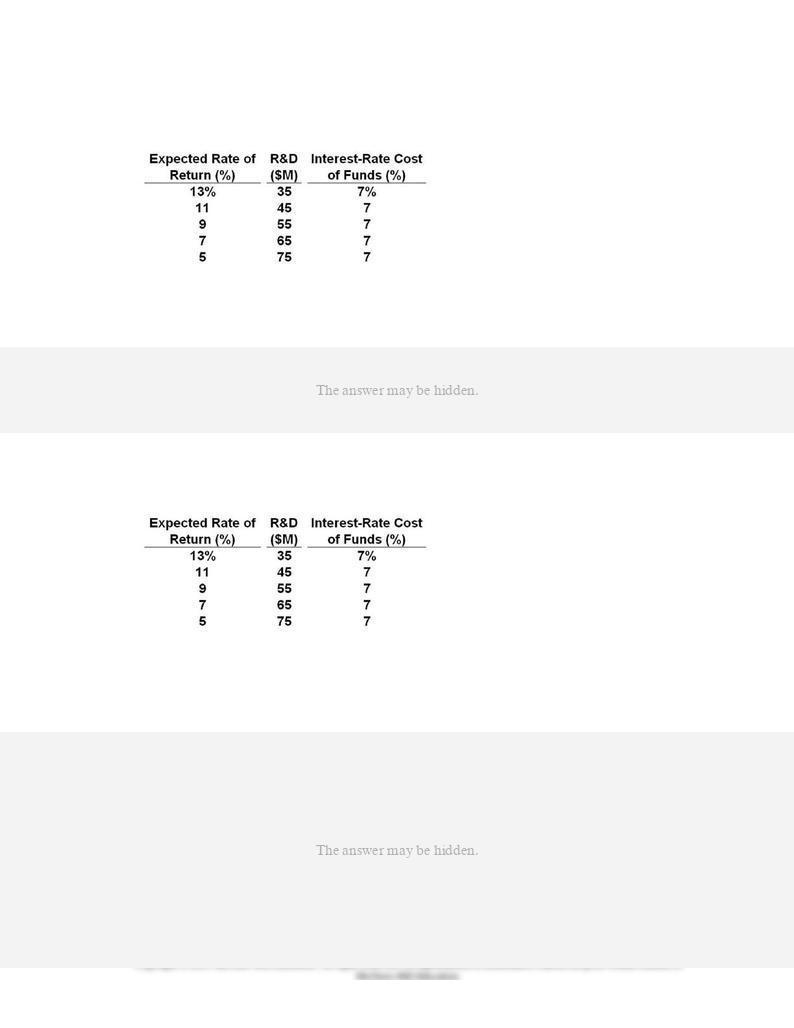
34.
The question is based on the following table showing the expected rate of return, R&D
spending, and interest-rate cost-of-funds for a hypothetical firm.
Refer to the above data. The optimal amount of R&D expenditure of the firm would be:
35.
The question is based on the following table showing the expected rate of return, R&D
spending, and interest-rate cost-of-funds for a hypothetical firm.
Refer the above data. If interest-rate cost-of-funds rose to 11 percent, the optimal amount of
R&D spending would be:
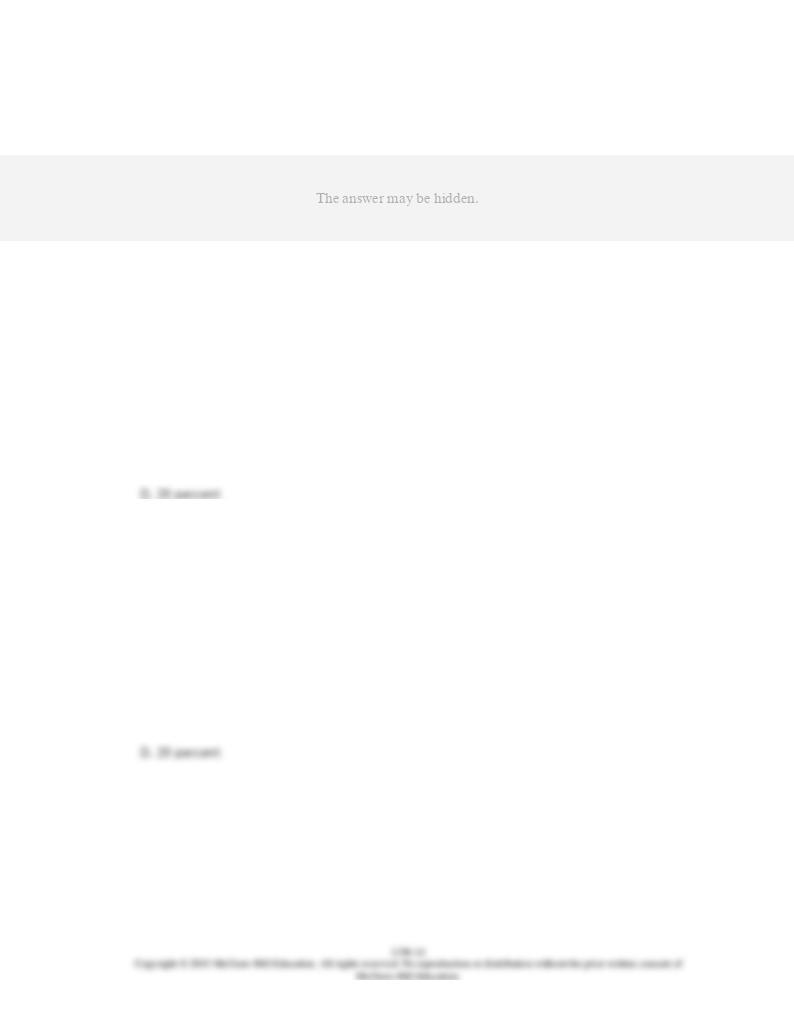
36.
A firm's marginal benefit from its R&D expenditures is the:
37.
A firm decides to make a $20 million expenditure on research and development that will
create a new product. This product is expected to increase the firm's revenues by a total of
$24 million in the next year. The firm also estimates that the production cost of the new
product will be $22 million. What is the expected rate of return on this research and
development expenditure?
A.
8.3 percent
B.
9.1 percent
C.
10 percent
38.
A firm decides to make a $20 million expenditure on research and development that will
create a new product. This product is expected to increase the firm's revenues by a total of
$24 million in the next year. The firm also estimates that the production cost of the new
product will be $22 million. If the firm has to take out a loan to finance the project, what is
the highest interest rate it will pay and still do the project among the choices given?
A.
8.3 percent
B.
9.1 percent
C.
10 percent

39.
The expected-rate-of-return curve for R&D expenditures of a firm slopes downward because
of:
40.
points:
A.
a
,
c
, and
e
B.
b
c
, and
e
C.
b
,
c
, and
d
D.
a
,
c
, and
d
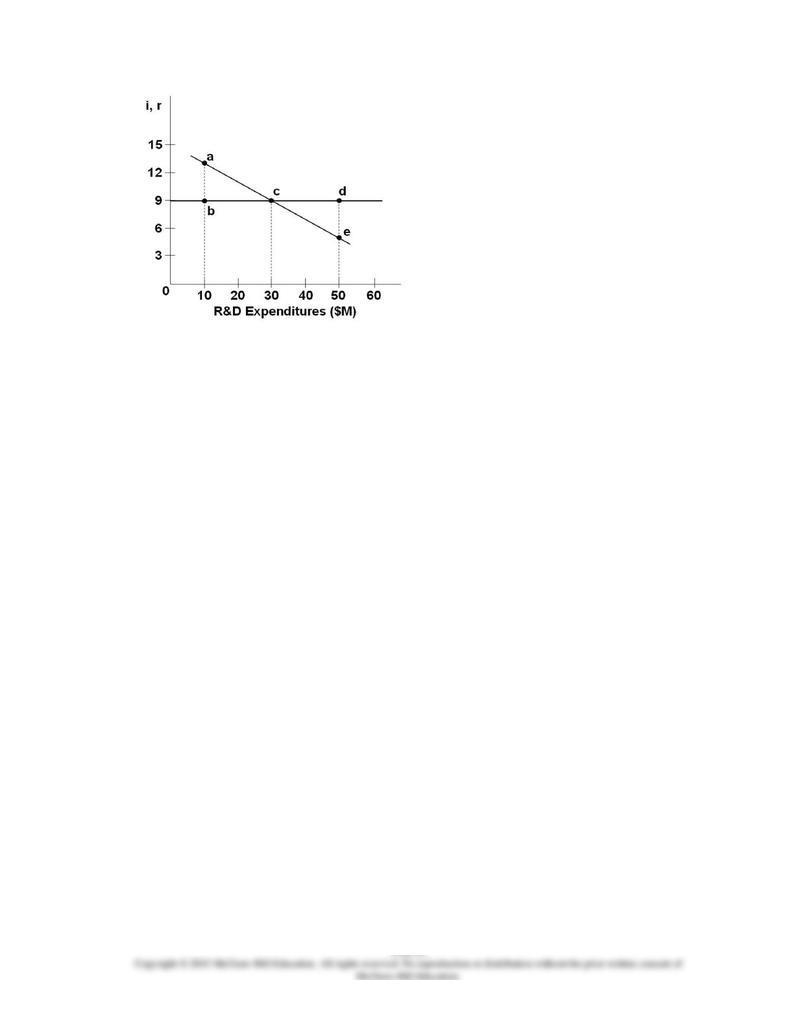
41.
In the above graph, the expected-rate-of-return curve would be the line connecting points:
A.
a
,
c
, and
e
B.
b
,
c
, and
e
C.
b
,
c
, and
d
D.
a,
c
, and
d
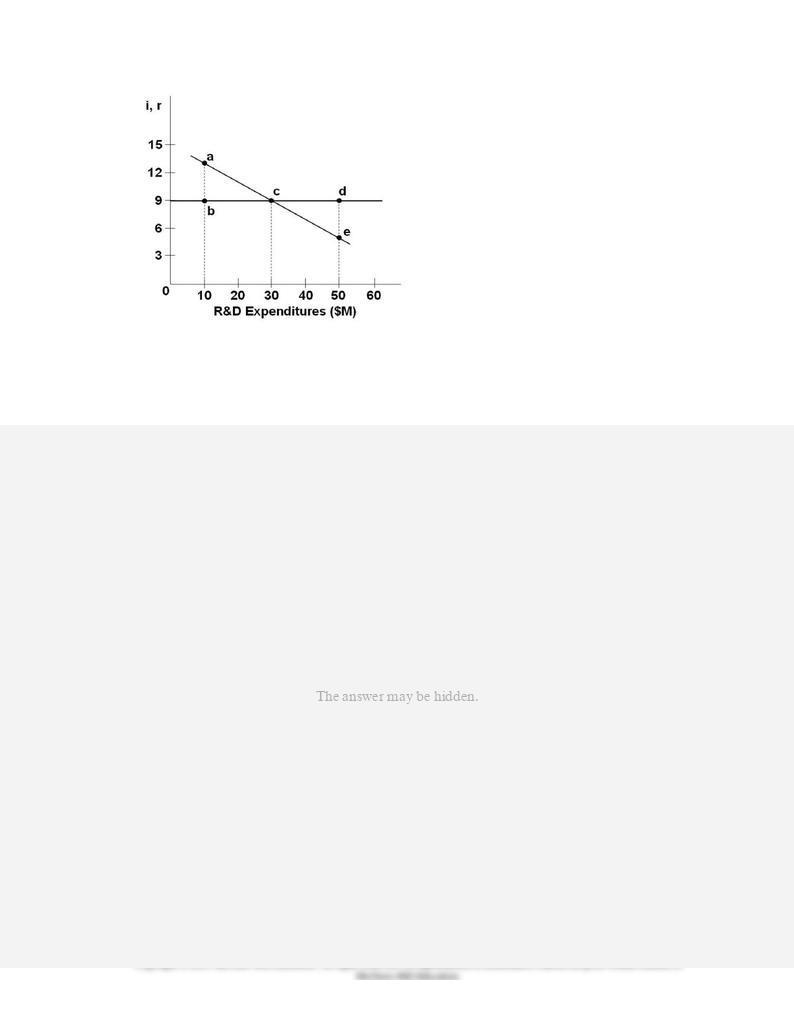
42.
In the above graph, the optimal amount of R&D spending and the interest-rate cost-of-funds
at that optimal level would be, respectively:
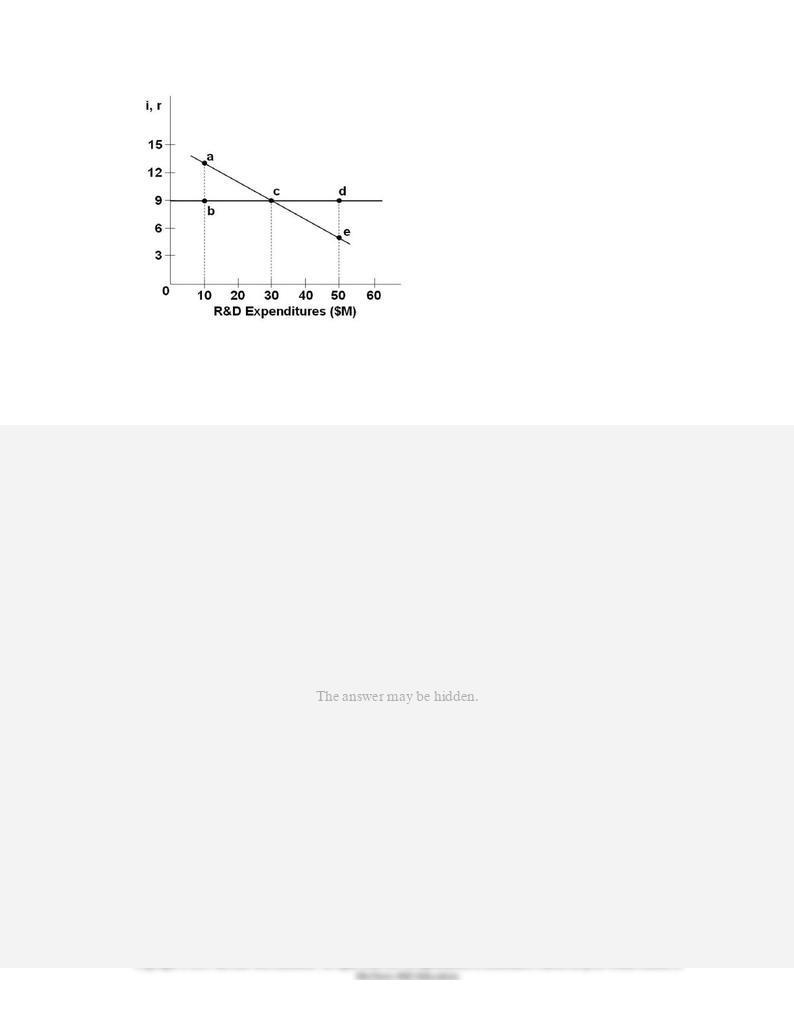
43.
In the above graph, the difference between points
a
and
b
indicates that at $10M of R&D
spending, the:

44.
In the above graph, the difference between points
d
and
e
indicate that at $50M of R&D
spending, the:
45.
The table below shows the rate of return and R&D spending for a hypothetical firm.
Refer to the above table. Assume the interest-rate cost of funds is 8 percent. What is the
optimal amount of R&D expenditures?
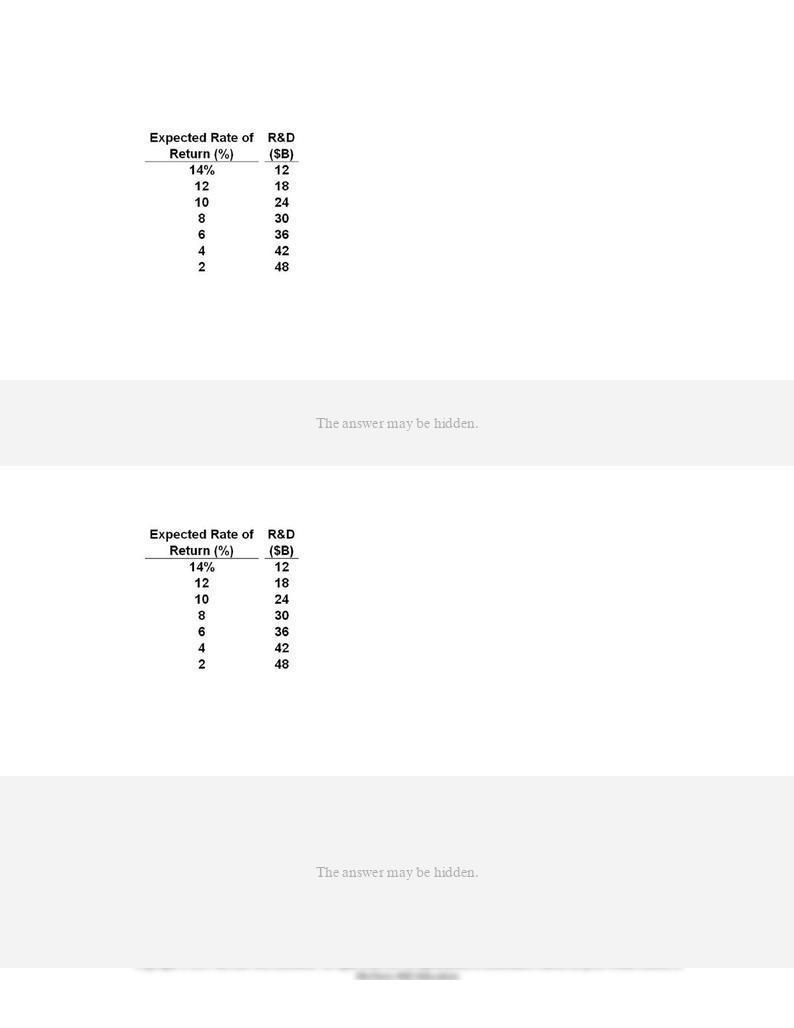
46.
The table below shows the rate of return and R&D spending for a hypothetical firm.
Refer to the above table. Assume the interest-rate cost of funds is 8 percent. What will be the
marginal cost and the marginal benefit of the optimal amount of R&D spending?
47.
The table below shows the rate of return and R&D spending for a hypothetical firm.
Refer to the above table. Assume the interest-rate cost of funds falls from 10 percent to 6
percent. What will happen to the optimal amount of R&D spending?

48.
An amount of R&D spending that is less than the optimal amount indicates that the:
49.
An amount of R&D spending that is greater than the optimal amount indicates that the:
50.
A firm should increase the amount of R&D expenditures to:
51.
The outcomes from R&D expenditures by firms are:

52.
The following can increase the profits of an innovating firm,
except
:
53.
Product innovation would be successful only if it makes the product's:
54.
Consumers will make a decision to purchase a new product only if it:
55.
A consumer had been consuming product X for some time. This period, she buys fewer X in
order to try some units of a new product Y. She finds that her marginal utility of X is 20 (at a
price of $10 per unit), while the marginal utility of Y is 36 (at a price of $12). The utility-
maximizing rule suggests that this consumer should:
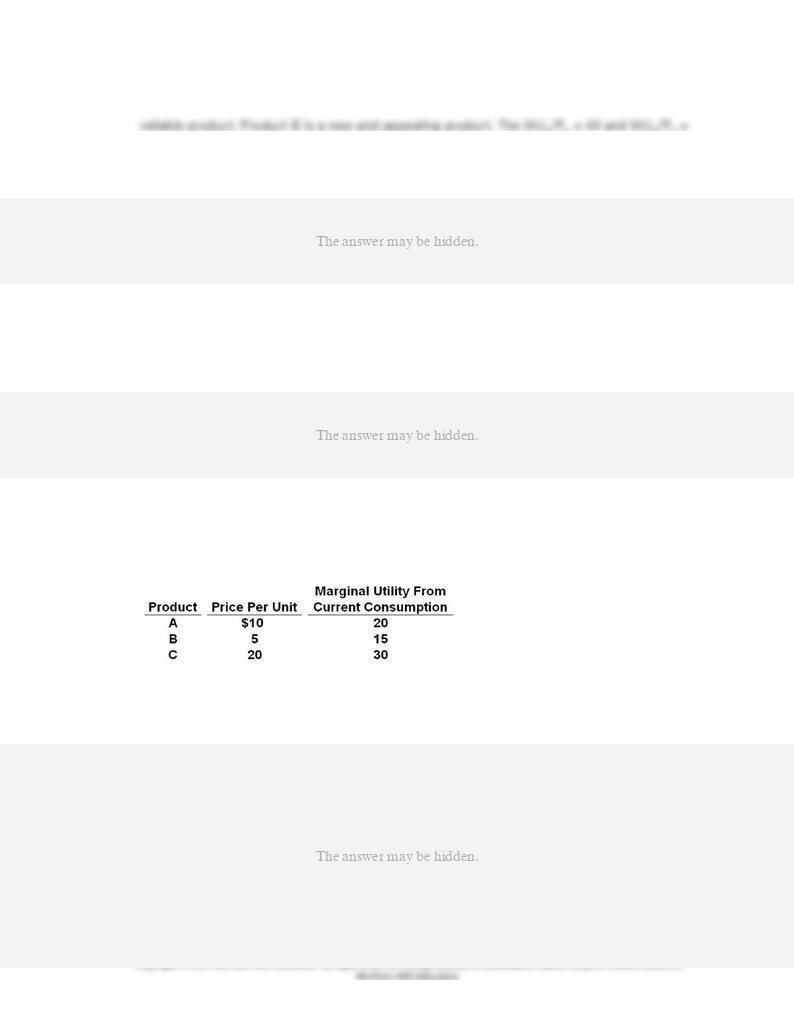
56.
Assume that a consumer purchases a combination of products. Product A is an old and
45. To maximize utility without spending more money, the consumer should:
57.
In choosing between an old reliable product versus a new attractive product, the consumer
will:
58.
The following table shows the marginal utilities derived from current consumption levels of
three new products, A, B, and C, that are now being sold in the market at the prices listed
below.
The consumer can immediately gain the most extra total utility by switching spending from:
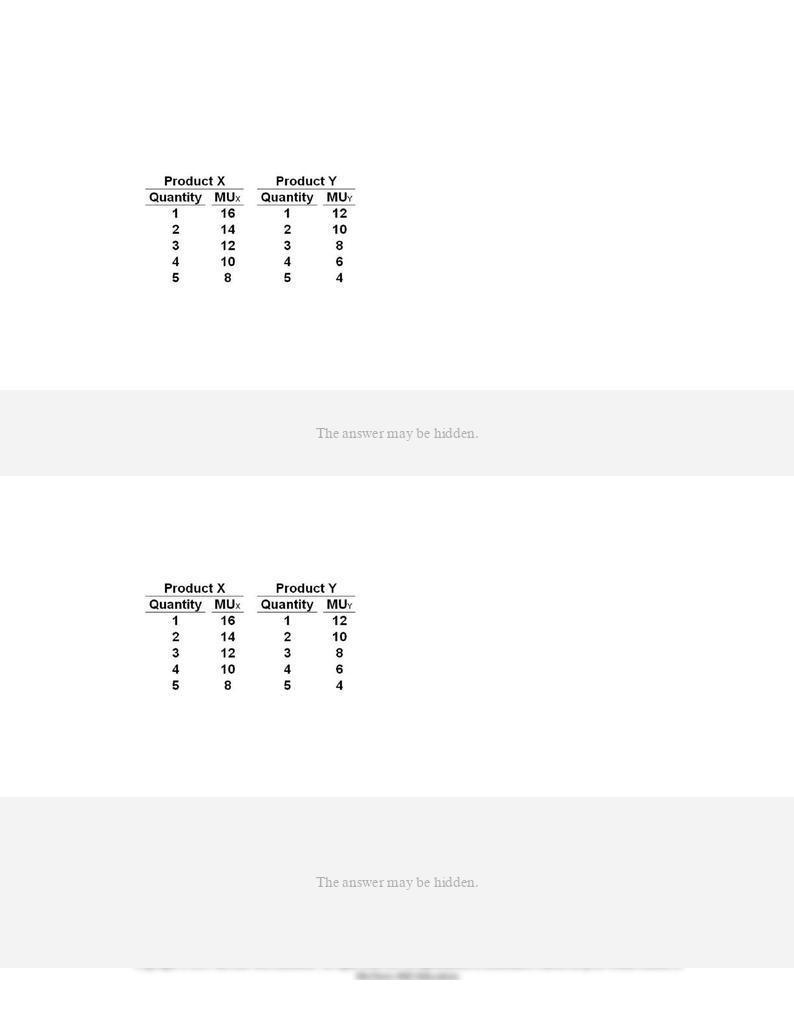
59.
The table below shows the marginal utility schedules for old product X and new product Y for
a hypothetical consumer. The price of X is $2 and the price of good Y is $1. The budget of the
consumer is $10.
Refer to the above table. If the consumer can only buy old product X, how much will the
consumer buy and what will be the total utility from spending the given budget?
60.
The table below shows the marginal utility schedules for old product X and new product Y for
a hypothetical consumer. The price of X is $2 and the price of good Y is $1. The budget of the
consumer is $10.
Refer to the above table. If the consumer buys both old product X and new product Y, how
much will the consumer buy of each to maximize utility?
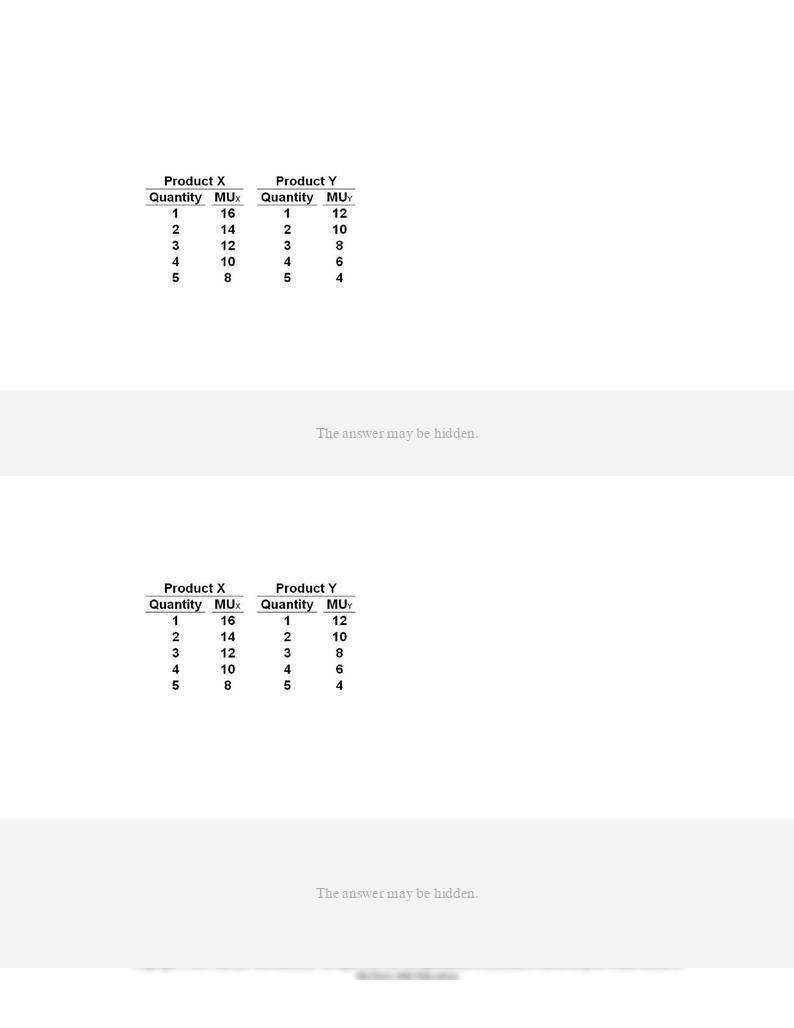
61.
The table below shows the marginal utility schedules for old product X and new product Y for
a hypothetical consumer. The price of X is $2 and the price of good Y is $1. The budget of the
consumer is $10.
Refer to the above table. When the consumer purchases the utility-maximizing combination
of old product X and new product Y, total utility will be:
62.
The table below shows the marginal utility schedules for old product X and new product Y for
a hypothetical consumer. The price of X is $2 and the price of good Y is $1. The budget of the
consumer is $10.
Refer to the above table. The consumer was originally limited to purchasing old product X but
now can also purchase new product Y. What is the increase in total utility from the original
situation when the consumer purchases the utility-maximizing combination of both X and Y?

63.
Consumer acceptance of a new product depends on:
64.
Which would be a good example of a
successful
introduction of a new product?
65.
Henry Ford's development of an assembly method for building cars and trucks would be an
example of:
66.
Process innovation will shift a firm's:

67.
If a firm improves its production method, this change will shift the firm's:
68.
If a firm develops better methods of producing a product, then this process innovation can be
expected to result in a(n):
69.
Assume a firm faces these costs: total cost of capital = $4,000; price paid for labor = $20 per
labor unit; and price paid for raw materials = $8 per raw-material unit.
Refer to the above information. If the firm can produce 2,000 units of output by combining its
fixed capital with 200 units of labor and 500 units of raw materials, what are the total cost
(TC) and average total cost (ATC) of producing the 2,000 units of output?

70.
Assume a firm faces these costs: total cost of capital = $4,000; price paid for labor = $20 per
labor unit; and price paid for raw materials = $8 per raw-material unit.
Refer to the above information. A firm improves its production process so that it can produce
3,000 units of output by combining its fixed capital with 100 units of labor and 500 units of
raw materials. What are the total cost and average cost of producing the 3,000 units of
output?
71.
Assume a firm faces these costs: total cost of capital = $4,000; price paid for labor = $20 per
labor unit; and price paid for raw materials = $8 per raw-material unit.
Refer to the above information. Originally the firm produced 2,000 units of output by
combining its fixed capital with 200 units of labor and 500 units of raw materials. Now the
firm improves its production process so that it can produce 3,000 units of output by
combining its fixed capital with 100 units of labor and 500 units of raw materials. What
happened to total cost?

72.
Assume a firm faces these costs: total cost of capital = $4,000; price paid for labor = $20 per
labor unit; and price paid for raw materials = $8 per raw-material unit.
Refer to the above information. Originally the firm produced 2,000 units of output by
combining its fixed capital with 200 units of labor and 500 units of raw materials. Now the
firm changes its production process so that it can produce 3,000 units of output by combining
its fixed capital with 100 units of labor and 500 units of raw materials. What happened to
average total cost?
73.
Assume a firm faces these costs: total cost of capital = $4,000; price paid for labor = $20 per
labor unit; and price paid for raw materials = $8 per raw-material unit.
Refer to the above information. Originally the firm produced 2,000 units of output by
combining its fixed capital with 200 units of labor and 500 units of raw materials. Now the
firm changes its production process so that it can produce 3,000 units of output by combining
its fixed capital with 100 units of labor and 500 units of raw materials. What valid conclusion
can be drawn about the effect and reasons for the change?

74.
Refer to the above diagram. Process innovation will tend to:
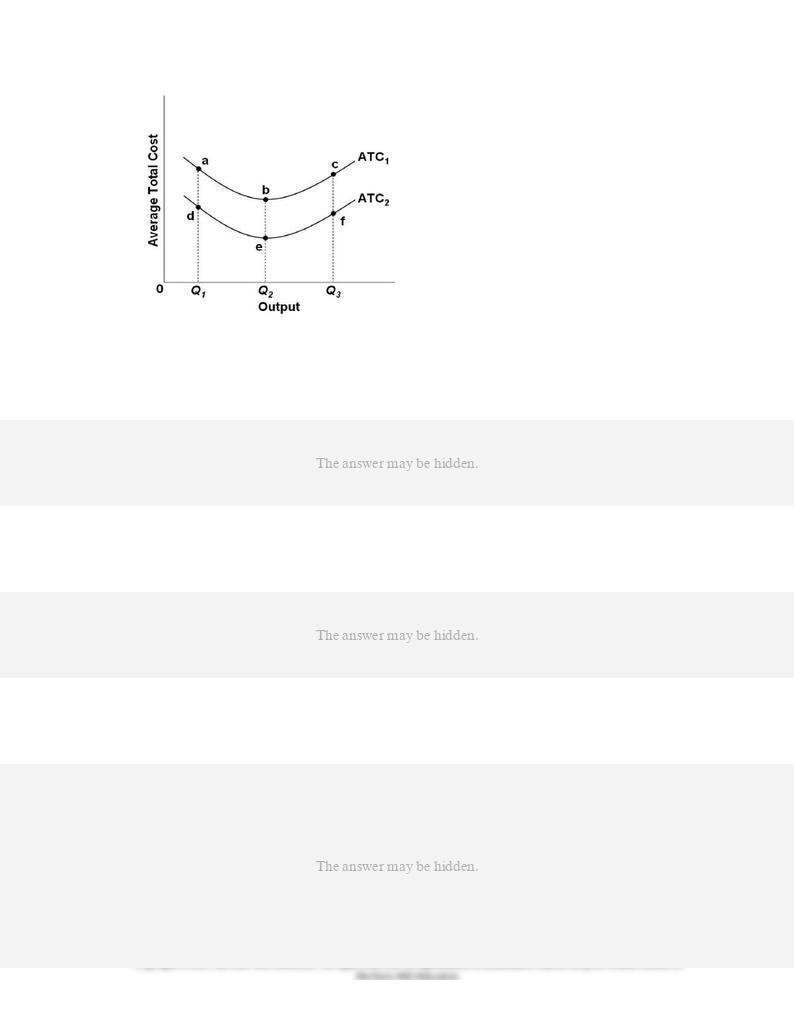
75.
Refer to the above diagram. Assume the firm is currently producing at Q1 with average cost
associated with point
a.
A process innovation will reduce average costs from point
a
to point:
76.
The following statements apply when a firm's rivals imitate its innovation,
except
:
77.
A "fast-second strategy" means that a dominant firm in an industry:

78.
When a dominant firm quickly copies the new product innovation of a smaller firm so that it is
the next firm to make the innovation, it is following a:
79.
The legal protection for publishers of books, computer software, movies, videos, and musical
compositions from having their works used or copied by others without their permission is a:
80.
The legal protection that gives the original innovators of products the exclusive right to use a
particular product name is a:
81.
A legal protection for taking the lead in innovation is:

82.
One of the major advantages of being the first to develop a product is:
83.
Which market structure has a strong incentive for product development and differentiation?
84.
Under which market structure are profit rewards most likely to be quickly taken away by
existing firms or new firms entering the industry?
85.
Which market structure is most likely to have the means and some incentive to innovate?

86.
Which two market structures have a strong need to innovate but have low expected returns
on R&D expenditures?
87.
Which market structure offers little incentive to engage in R&D?
88.
The "Inverted-U theory" of R&D shows the relationship between:
89.
An industry with which of the following four-firm concentration ratios would tend to have the
greatest amount of R&D expenditures as a percentage of sales?

90.
According to the inverted-U theory, R&D expenditures as a percentage of sales tend to be
relatively low in:
91.
The optimal market structure for technological advance seems to be an industry in which:
92.
Besides market structure, another factor that seems to influence the level of R&D spending
in an industry is the:
93.
One of the outcomes for society from product innovation is:

94.
Process innovation leads to technological advance because it:
95.
Product innovation contributes to technological advance primarily by:
96.
In the 1800s, railroads broke up the monopoly position of wagons, ships, and barges as the
major means of transporting goods. This would be an example of:
97.
In the music industry, cassette tapes were replaced by compact discs, which in turn are
replaced by the iPod and MP3 technology. This process would be an example of:

98.
Joseph Schumpeter viewed capitalism as a process of "creative destruction" because:
99.
To maintain returns from research and development, firms:
100.
All of the following statements are true about technological advance,
except
:
101.
Compared to the mid-1960s, the percentage of the U.S. Federal budget spent on R&D in
recent years is:

102.
Which of the following programs receives the smallest share of total Federal spending?
103.
Technological advance consists of short-run adjustments to the production process that
reduce costs.
104.
Inventions and innovations can both be patented.
105.
Innovation pertains to commercialization, while invention pertains more to scientific
research.
106.
U.S. business firms channel a majority of their R&D expenditures to scientific research.
107.
The modern view of technological advance is that it is an external force to which the
economy adjusts.

108.
Many economists view technological advance as mainly a response to profit opportunities
arising within a capitalist economy, and not some random external force.
109.
All inventors are entrepreneurs.
110.
R&D activities by government and universities have not been an important factor in fostering
technological advance.
111.
Entrepreneurs often form new small firms called "spin-off firms".
112.
When entrepreneurs use their own personal savings to finance the R&D for their new
venture, the marginal cost of financing is zero.
113.
When corporations use retained earnings to finance the R&D for a new venture the marginal
cost of financing is zero.
114.
The optimal amount of R&D spending for the firm occurs where its expected return is equal
to the interest-rate cost-of-funds to finance it.
115.
If an R&D activity is affordable, the firm should spend on that activity.

116.
If a particular R&D expenditure is expected to be worthwhile, the firm should undertake it
because the project will definitely increase the firm's future profits.
117.
Consumers will buy a new product instead of an old one that they are used to buying, if the
MU of the new product is larger than the MU of the old product.
118.
Most product innovations consist of minor changes to existing products and are incremental
improvements.
119.
Process innovation raises the firm's total product curve and lowers its average total cost
curve.
120.
One of the advantages of being first to develop a new product is the opportunity to develop
brand-name recognition.
121.
A "fast-second strategy" refers to a situation where small competitors of a dominant firm will
wait for the dominant firm to innovate, and then quickly imitate the dominant firm's
innovations.
122.
Pure monopoly is the best market structure for encouraging R&D and innovation.

123.
The inverted-U theory suggests that R&D effort is strongest in very high concentration
industries.
124.
The technical and scientific characteristics of an industry may be less important than its
structure in determining R&D spending and innovation.
125.
Technological advance may lead to new monopolies, and may also destroy existing
monopolies.
126.
Creative destruction is the situation where the creation of new products destroys the
monopoly market positions of firms producing existing products.
127.
The U.S. government has been increasing the portion of its budget and its spending on R&D
activities, for the nation's long-term growth.

Chapter 13W Technology, R&D, and Efficiency Answer Key
Multiple Choice Questions
1.
Technological advance is a three-step process of:
AACSB: Analytic
Accessibility: Keyboard Navigation
Blooms: Remember
Difficulty: 1 Easy
Learning Objective: 13W-01 Differentiate between invention; innovation; and technological diffusion.
Topic: Invention, Innovation, and Diffusion
2.
The discovery of a product or process through the use of imagination, ingenious thinking,
and experimentation is:
AACSB: Analytic
AACSB: Communication
Accessibility: Keyboard Navigation
Blooms: Remember
Difficulty: 1 Easy
Learning Objective: 13W-01 Differentiate between invention; innovation; and technological diffusion.
Topic: Invention, Innovation, and Diffusion

3.
The first successful commercial introduction of a new product is called:
AACSB: Analytic
AACSB: Communication
Accessibility: Keyboard Navigation
Blooms: Remember
Difficulty: 1 Easy
Learning Objective: 13W-01 Differentiate between invention; innovation; and technological diffusion.
Topic: Invention, Innovation, and Diffusion
4.
In analyzing a market, the time horizon where technology can change and firms can offer
new products is referred to as the:
AACSB: Analytic
Accessibility: Keyboard Navigation
Blooms: Remember
Difficulty: 1 Easy
Learning Objective: 13W-01 Differentiate between invention; innovation; and technological diffusion.
Topic: Invention, Innovation, and Diffusion
5.
The first working prototype of a microcomputer chip would be an example of an:
AACSB: Analytic
AACSB: Communication

Accessibility: Keyboard Navigation
Blooms: Remember
Difficulty: 1 Easy
Learning Objective: 13W-01 Differentiate between invention; innovation; and technological diffusion.
Topic: Invention, Innovation, and Diffusion
6.
A common way by which governments encourage invention is by providing the inventor
with a:
AACSB: Analytic
Accessibility: Keyboard Navigation
Blooms: Remember
Difficulty: 1 Easy
Learning Objective: 13W-01 Differentiate between invention; innovation; and technological diffusion.
Topic: Invention, Innovation, and Diffusion
7.
The worldwide duration of patents that begins at the time of application is:
AACSB: Analytic
Accessibility: Keyboard Navigation
Blooms: Remember
Difficulty: 1 Easy
Learning Objective: 13W-01 Differentiate between invention; innovation; and technological diffusion.
Topic: Invention, Innovation, and Diffusion

8.
Which of the following does not aptly describe innovation?
AACSB: Analytic
Accessibility: Keyboard Navigation
Blooms: Remember
Difficulty: 1 Easy
Learning Objective: 13W-01 Differentiate between invention; innovation; and technological diffusion.
Topic: Invention, Innovation, and Diffusion
9.
The introduction of the iPhone by Apple is an example of a(n):
AACSB: Analytic
AACSB: Communication
Accessibility: Keyboard Navigation
Blooms: Remember
Difficulty: 1 Easy
Learning Objective: 13W-01 Differentiate between invention; innovation; and technological diffusion.
Topic: Invention, Innovation, and Diffusion
10.
The spread of an innovation to other products through imitation is called:
AACSB: Analytic
AACSB: Communication
Accessibility: Keyboard Navigation

Blooms: Remember
Difficulty: 1 Easy
Learning Objective: 13W-01 Differentiate between invention; innovation; and technological diffusion.
Topic: Invention, Innovation, and Diffusion
11.
The reason that innovation promotes competition is because:
AACSB: Analytic
Accessibility: Keyboard Navigation
Blooms: Remember
Difficulty: 1 Easy
Learning Objective: 13W-01 Differentiate between invention; innovation; and technological diffusion.
Topic: Invention, Innovation, and Diffusion
12.
The following are examples of innovative products in their respective industries, except:
AACSB: Analytic
Accessibility: Keyboard Navigation
Blooms: Remember
Difficulty: 2 Medium
Learning Objective: 13W-01 Differentiate between invention; innovation; and technological diffusion.
Topic: Invention, Innovation, and Diffusion

13.
What idea is best illustrated by the example of Alamo auto rentals offering unlimited
mileage to drivers and the practice being adopted by other auto rental firms?
AACSB: Analytic
Accessibility: Keyboard Navigation
Blooms: Remember
Difficulty: 2 Medium
Learning Objective: 13W-01 Differentiate between invention; innovation; and technological diffusion.
Topic: Invention, Innovation, and Diffusion
14.
In 2011, which of the following nations ranked highest in total R&D expenditures as a
percent of GDP?
AACSB: Analytic
Accessibility: Keyboard Navigation
Blooms: Remember
Difficulty: 1 Easy
Learning Objective: 13W-01 Differentiate between invention; innovation; and technological diffusion.
Topic: Invention, Innovation, and Diffusion

15.
About what percentage of research and development spending by businesses in the
United States in 2009 went to development (innovation and imitation) and about what
percentage went to basic research and invention, respectively?
AACSB: Analytic
Accessibility: Keyboard Navigation
Blooms: Remember
Difficulty: 1 Easy
Learning Objective: 13W-01 Differentiate between invention; innovation; and technological diffusion.
Topic: Invention, Innovation, and Diffusion
16.
What activity traditionally receives the largest share of total business spending on R&D
(research and development) in the U.S.?
AACSB: Analytic
Accessibility: Keyboard Navigation
Blooms: Remember
Difficulty: 1 Easy
Learning Objective: 13W-01 Differentiate between invention; innovation; and technological diffusion.
Topic: Invention, Innovation, and Diffusion

17.
The modern view of technological advance is that it:
AACSB: Analytic
Accessibility: Keyboard Navigation
Blooms: Remember
Difficulty: 2 Medium
Learning Objective: 13W-01 Differentiate between invention; innovation; and technological diffusion.
Topic: Invention, Innovation, and Diffusion
18.
The traditional view of technological advance was that it:
AACSB: Analytic
Accessibility: Keyboard Navigation
Blooms: Remember
Difficulty: 1 Easy
Learning Objective: 13W-01 Differentiate between invention; innovation; and technological diffusion.
Topic: Invention, Innovation, and Diffusion
19.
Entrepreneurs are those people who are:
AACSB: Analytic
Accessibility: Keyboard Navigation
Blooms: Remember
Difficulty: 1 Easy

Learning Objective: 13W-02 Explain how entrepreneurs and other innovators further technological advance.
Topic: Role of Entrepreneurs and Other Innovators
20.
Entrepreneurs differ from other innovators because they:
AACSB: Analytic
Accessibility: Keyboard Navigation
Blooms: Remember
Difficulty: 1 Easy
Learning Objective: 13W-02 Explain how entrepreneurs and other innovators further technological advance.
Topic: Role of Entrepreneurs and Other Innovators
21.
Which of the following firms was not a "start-up"?
AACSB: Analytic
Accessibility: Keyboard Navigation
Blooms: Remember
Difficulty: 1 Easy
Learning Objective: 13W-02 Explain how entrepreneurs and other innovators further technological advance.
Topic: Role of Entrepreneurs and Other Innovators
22.
Which of the following is a "spin-off firm"?
AACSB: Analytic

Accessibility: Keyboard Navigation
Blooms: Remember
Difficulty: 2 Medium
Learning Objective: 13W-02 Explain how entrepreneurs and other innovators further technological advance.
Topic: Role of Entrepreneurs and Other Innovators
23.
Entrepreneurs and innovative firms with past successes in developing products:
AACSB: Analytic
Accessibility: Keyboard Navigation
Blooms: Remember
Difficulty: 1 Easy
Learning Objective: 13W-02 Explain how entrepreneurs and other innovators further technological advance.
Topic: Role of Entrepreneurs and Other Innovators
24.
Which would be an example of innovation within an existing business firm?
AACSB: Analytic
Accessibility: Keyboard Navigation
Blooms: Remember
Difficulty: 2 Medium
Learning Objective: 13W-02 Explain how entrepreneurs and other innovators further technological advance.
Topic: Role of Entrepreneurs and Other Innovators

25.
Which of the following would be the best example of a "start-up"?
AACSB: Analytic
Accessibility: Keyboard Navigation
Blooms: Remember
Difficulty: 2 Medium
Learning Objective: 13W-02 Explain how entrepreneurs and other innovators further technological advance.
Topic: Role of Entrepreneurs and Other Innovators
26.
Which of the following are aptly considered entrepreneurs?
AACSB: Analytic
AACSB: Communication
Accessibility: Keyboard Navigation
Blooms: Remember
Difficulty: 1 Easy
Learning Objective: 13W-02 Explain how entrepreneurs and other innovators further technological advance.
Topic: Role of Entrepreneurs and Other Innovators
27.
Why is the percentage of business research and development spending for basic research
so small?
AACSB: Analytic
Accessibility: Keyboard Navigation

Blooms: Remember
Difficulty: 2 Medium
Learning Objective: 13W-02 Explain how entrepreneurs and other innovators further technological advance.
Topic: Role of Entrepreneurs and Other Innovators
28.
What is an example of a technological breakthrough that came out of a government or
university laboratory?
AACSB: Analytic
Accessibility: Keyboard Navigation
Blooms: Remember
Difficulty: 2 Medium
Learning Objective: 13W-02 Explain how entrepreneurs and other innovators further technological advance.
Topic: Role of Entrepreneurs and Other Innovators
29.
The following are examples of technological breakthroughs that came out of a government
or university laboratory, except:
AACSB: Analytic
Accessibility: Keyboard Navigation
Blooms: Remember
Difficulty: 2 Medium
Learning Objective: 13W-02 Explain how entrepreneurs and other innovators further technological advance.
Topic: Role of Entrepreneurs and Other Innovators

30.
Venture capital refers to:
AACSB: Analytic
AACSB: Communication
Accessibility: Keyboard Navigation
Blooms: Remember
Difficulty: 2 Medium
Learning Objective: 13W-02 Explain how entrepreneurs and other innovators further technological advance.
Topic: Role of Entrepreneurs and Other Innovators
31.
The marginal cost-of-funds curve for a firm shows the:
AACSB: Analytic
Accessibility: Keyboard Navigation
Blooms: Remember
Difficulty: 1 Easy
Learning Objective: 13W-03 Summarize how a firm determines its optimal amount of research and development (R and
D).
Topic: A Firm's Optimal Amount of R and D
32.
The optimal amount of R&D for a firm depends on the following,
except
:
AACSB: Analytic
Accessibility: Keyboard Navigation
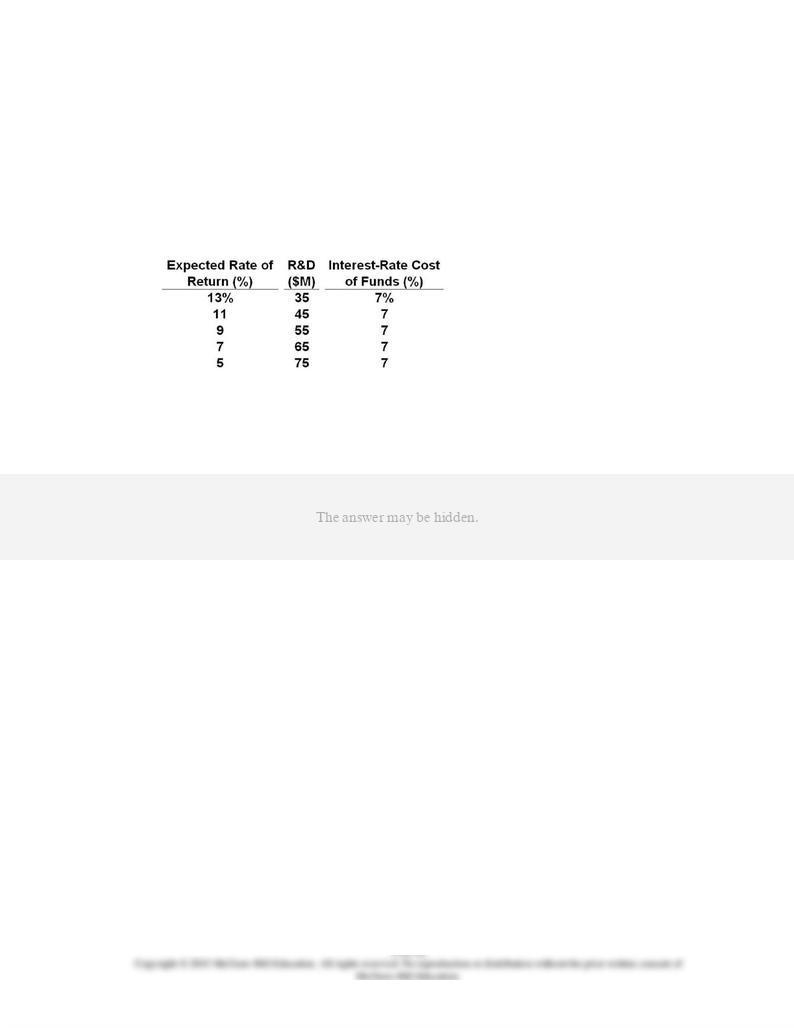
Blooms: Remember
Difficulty: 2 Medium
Learning Objective: 13W-03 Summarize how a firm determines its optimal amount of research and development (R and
D).
Topic: A Firm's Optimal Amount of R and D
33.
The question is based on the following table showing the expected rate of return, R&D
spending, and interest-rate cost-of-funds for a hypothetical firm.
Refer to the above data. In a graph for determining the optimal R&D expenditure, the
interest-cost of funds curve would be a(n):
AACSB: Analytic
Blooms: Understand
Difficulty: 2 Medium
Learning Objective: 13W-03 Summarize how a firm determines its optimal amount of research and development (R and
D).
Topic: A Firm's Optimal Amount of R and D

34.
The question is based on the following table showing the expected rate of return, R&D
spending, and interest-rate cost-of-funds for a hypothetical firm.
Refer to the above data. The optimal amount of R&D expenditure of the firm would be:
AACSB: Analytic
Blooms: Apply
Difficulty: 2 Medium
Learning Objective: 13W-03 Summarize how a firm determines its optimal amount of research and development (R and
D).
Topic: A Firm's Optimal Amount of R and D
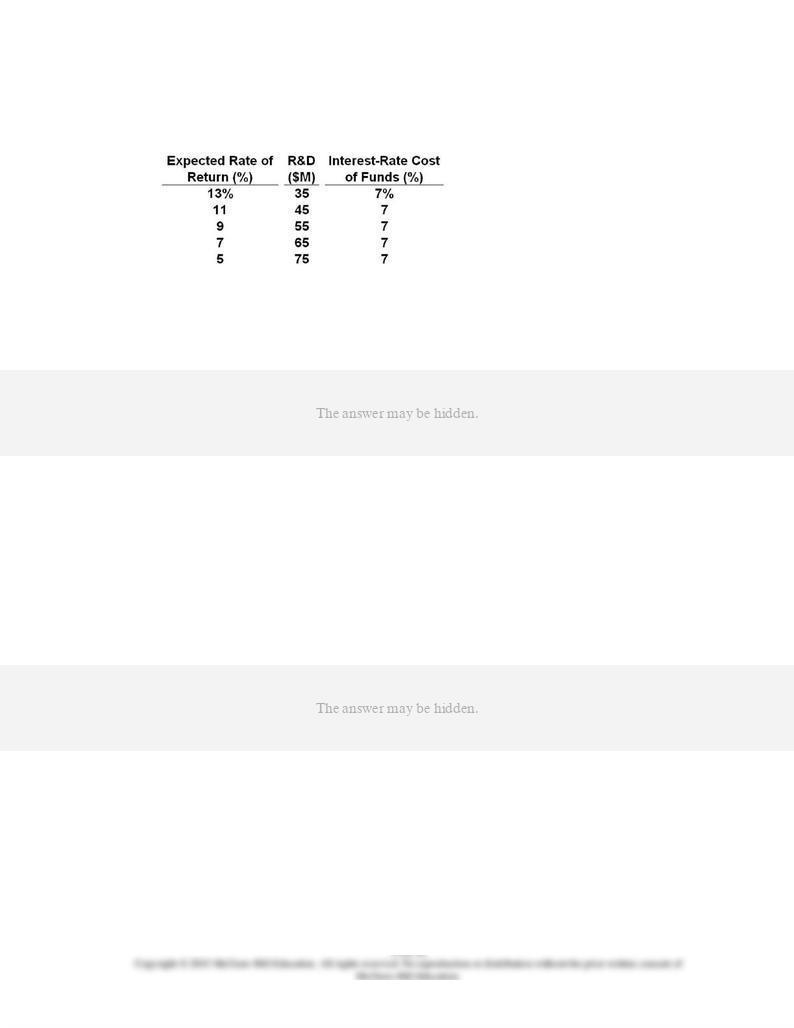
35.
The question is based on the following table showing the expected rate of return, R&D
spending, and interest-rate cost-of-funds for a hypothetical firm.
Refer the above data. If interest-rate cost-of-funds rose to 11 percent, the optimal amount
of R&D spending would be:
AACSB: Analytic
Blooms: Apply
Difficulty: 2 Medium
Learning Objective: 13W-03 Summarize how a firm determines its optimal amount of research and development (R and
D).
Topic: A Firm's Optimal Amount of R and D
36.
A firm's marginal benefit from its R&D expenditures is the:
AACSB: Analytic
Accessibility: Keyboard Navigation
Blooms: Remember
Difficulty: 2 Medium
Learning Objective: 13W-03 Summarize how a firm determines its optimal amount of research and development (R and
D).
Topic: A Firm's Optimal Amount of R and D

37.
A firm decides to make a $20 million expenditure on research and development that will
create a new product. This product is expected to increase the firm's revenues by a total
of $24 million in the next year. The firm also estimates that the production cost of the new
product will be $22 million. What is the expected rate of return on this research and
development expenditure?
A.
8.3 percent
B.
9.1 percent
C.
10 percent
AACSB: Analytic
Accessibility: Keyboard Navigation
Blooms: Apply
Difficulty: 2 Medium
Learning Objective: 13W-03 Summarize how a firm determines its optimal amount of research and development (R and
D).
Topic: A Firm's Optimal Amount of R and D
38.
A firm decides to make a $20 million expenditure on research and development that will
create a new product. This product is expected to increase the firm's revenues by a total
of $24 million in the next year. The firm also estimates that the production cost of the new
product will be $22 million. If the firm has to take out a loan to finance the project, what is
the highest interest rate it will pay and still do the project among the choices given?
A.
8.3 percent
B.
9.1 percent
C.
10 percent
AACSB: Analytic
Accessibility: Keyboard Navigation
Blooms: Apply
Difficulty: 2 Medium
Learning Objective: 13W-03 Summarize how a firm determines its optimal amount of research and development (R and
D).
Topic: A Firm's Optimal Amount of R and D
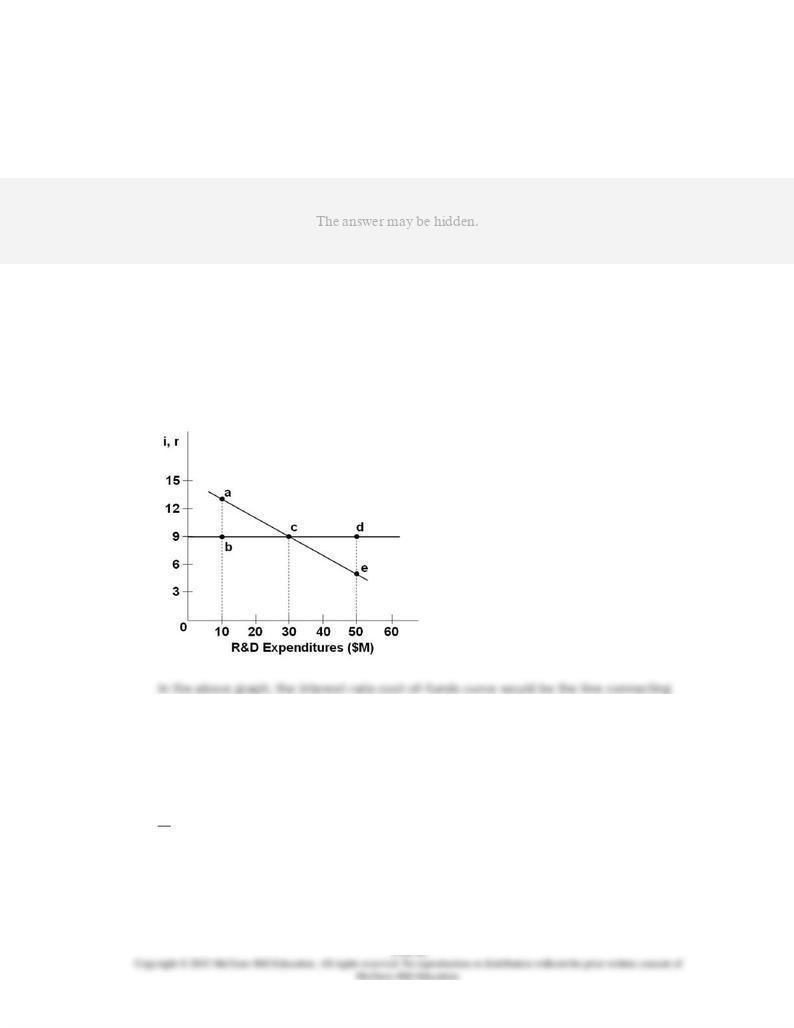
39.
The expected-rate-of-return curve for R&D expenditures of a firm slopes downward
because of:
AACSB: Analytic
Accessibility: Keyboard Navigation
Blooms: Apply
Difficulty: 1 Easy
Learning Objective: 13W-03 Summarize how a firm determines its optimal amount of research and development (R and
D).
Topic: A Firm's Optimal Amount of R and D
40.
points:
A.
a
,
c
, and
e
B.
b
c
, and
e
C.
b
,
c
, and
d
D.
a
,
c
, and
d
AACSB: Analytic
Blooms: Remember
Difficulty: 1 Easy
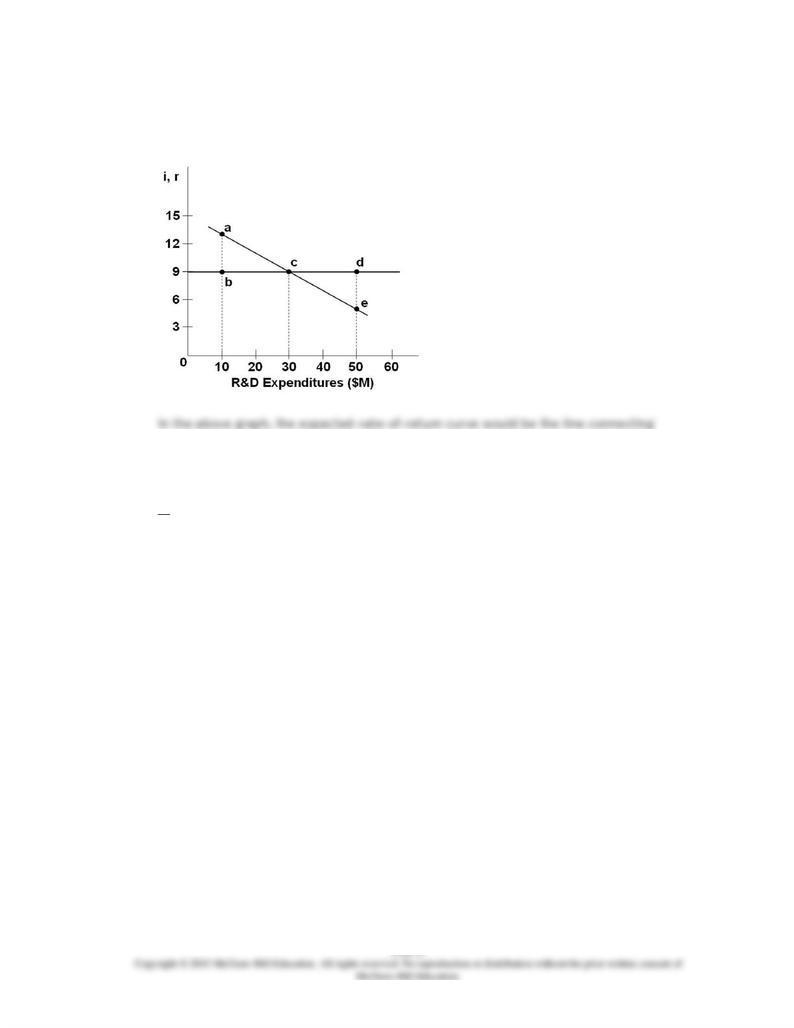
Learning Objective: 13W-03 Summarize how a firm determines its optimal amount of research and development (R and
D).
Topic: A Firm's Optimal Amount of R and D
41.
points:
A.
a
,
c
, and
e
B.
b
,
c
, and
e
C.
b
,
c
, and
d
D.
a,
c
, and
d
AACSB: Analytic
Blooms: Remember
Difficulty: 1 Easy
Learning Objective: 13W-03 Summarize how a firm determines its optimal amount of research and development (R and
D).
Topic: A Firm's Optimal Amount of R and D
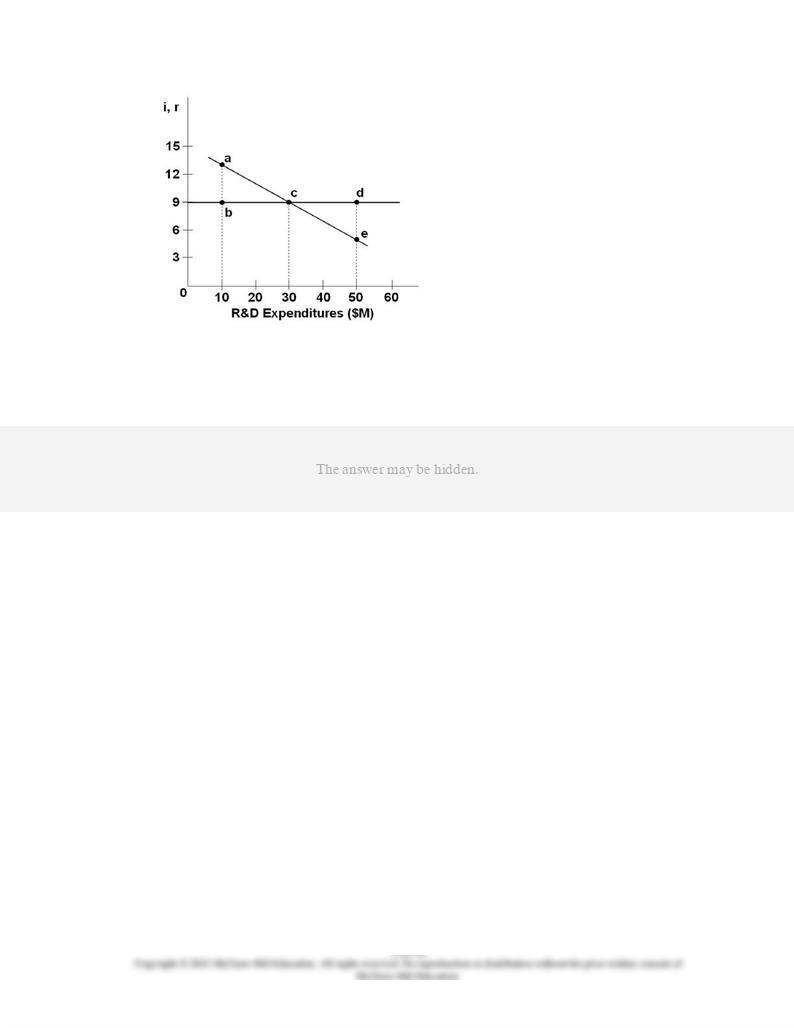
42.
In the above graph, the optimal amount of R&D spending and the interest-rate cost-of-
funds at that optimal level would be, respectively:
AACSB: Analytic
Blooms: Apply
Difficulty: 2 Medium
Learning Objective: 13W-03 Summarize how a firm determines its optimal amount of research and development (R and
D).
Topic: A Firm's Optimal Amount of R and D
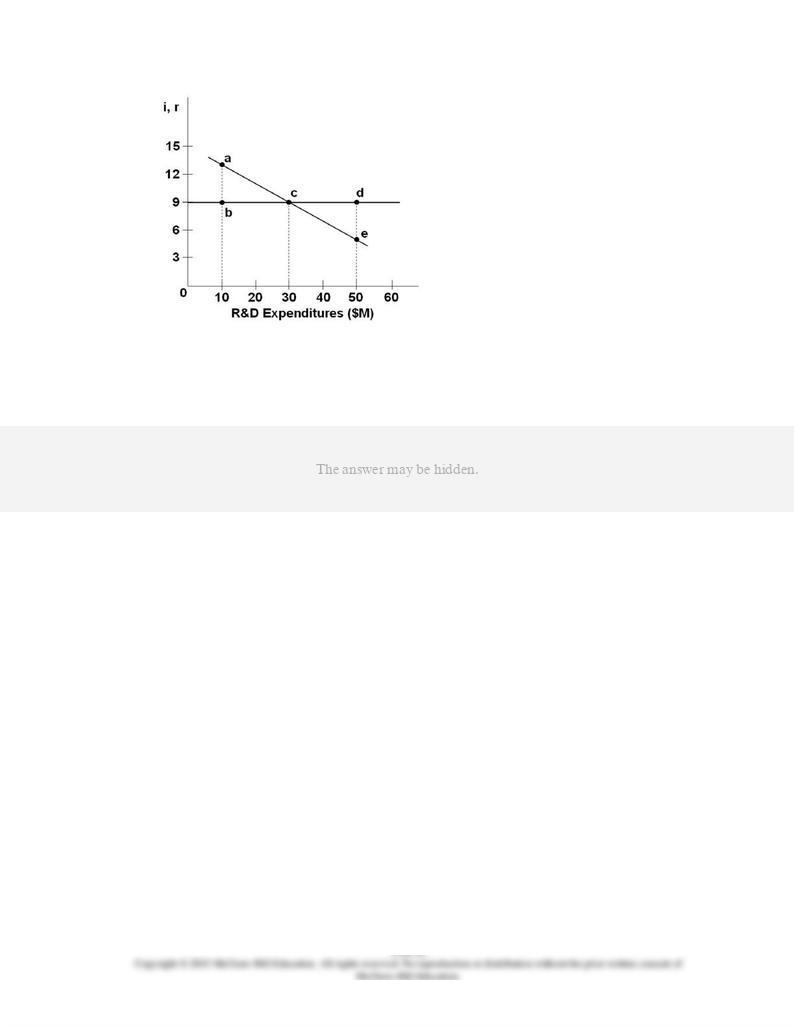
43.
In the above graph, the difference between points
a
and
b
indicates that at $10M of R&D
spending, the:
AACSB: Analytic
Blooms: Apply
Difficulty: 1 Easy
Learning Objective: 13W-03 Summarize how a firm determines its optimal amount of research and development (R and
D).
Topic: A Firm's Optimal Amount of R and D
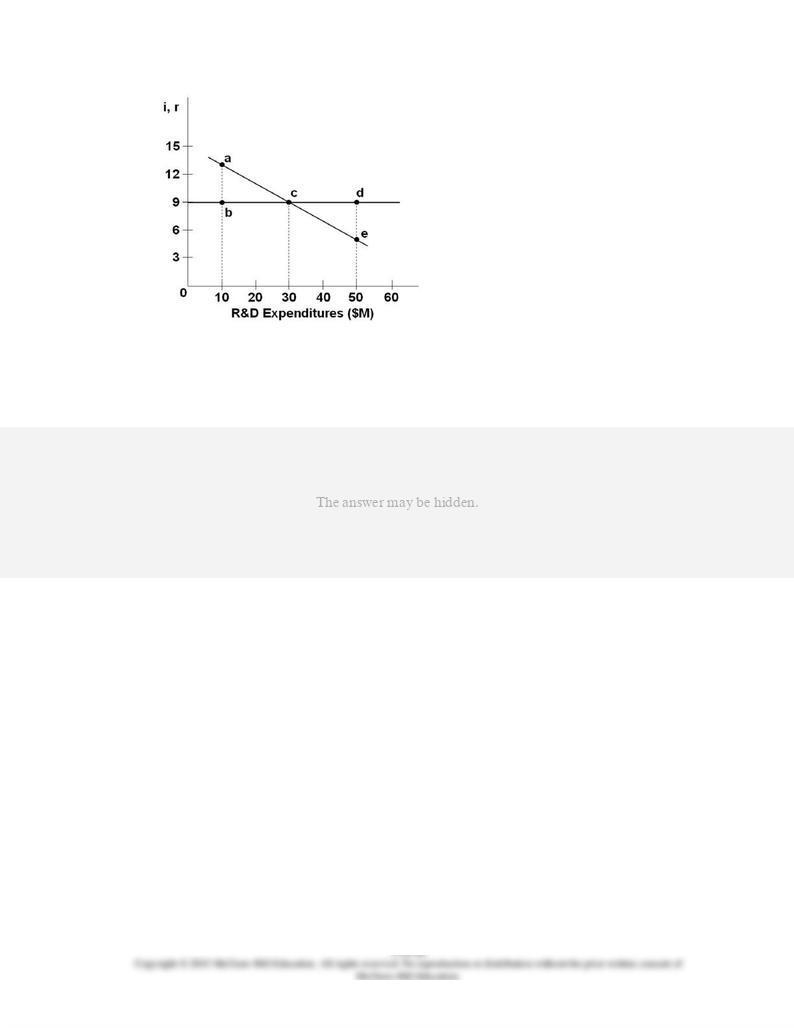
44.
In the above graph, the difference between points
d
and
e
indicate that at $50M of R&D
spending, the:
AACSB: Analytic
Blooms: Apply
Difficulty: 1 Easy
Learning Objective: 13W-03 Summarize how a firm determines its optimal amount of research and development (R and
D).
Topic: A Firm's Optimal Amount of R and D
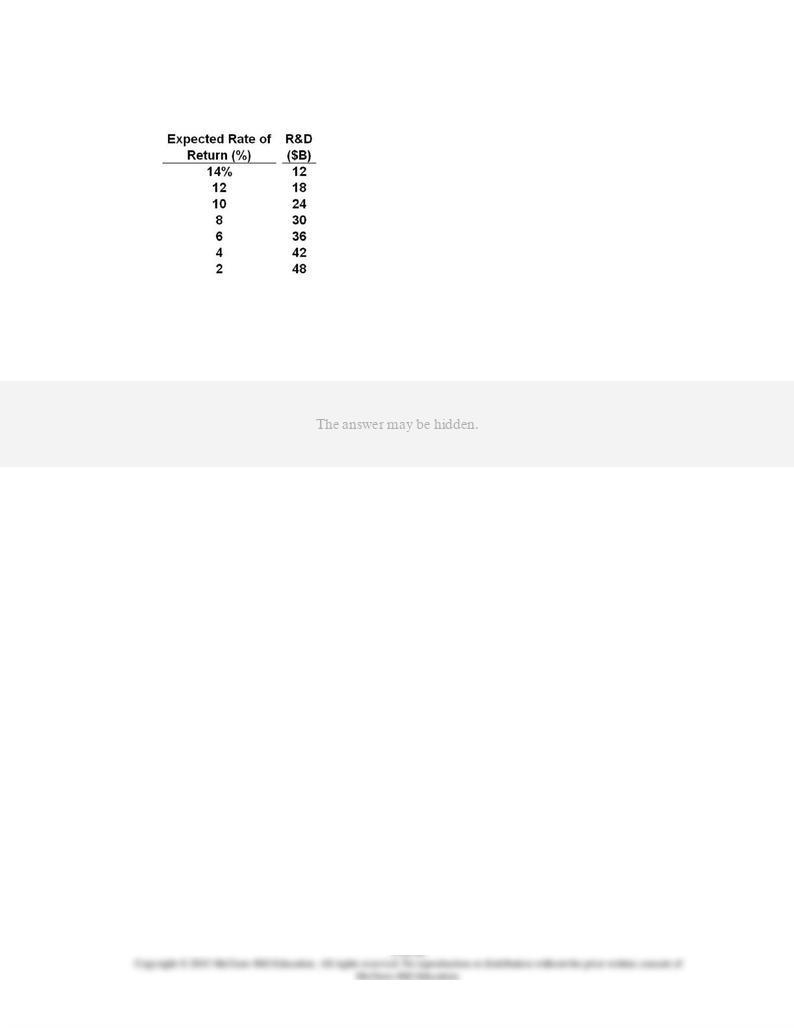
45.
The table below shows the rate of return and R&D spending for a hypothetical firm.
Refer to the above table. Assume the interest-rate cost of funds is 8 percent. What is the
optimal amount of R&D expenditures?
AACSB: Analytic
Blooms: Apply
Difficulty: 2 Medium
Learning Objective: 13W-03 Summarize how a firm determines its optimal amount of research and development (R and
D).
Topic: A Firm's Optimal Amount of R and D
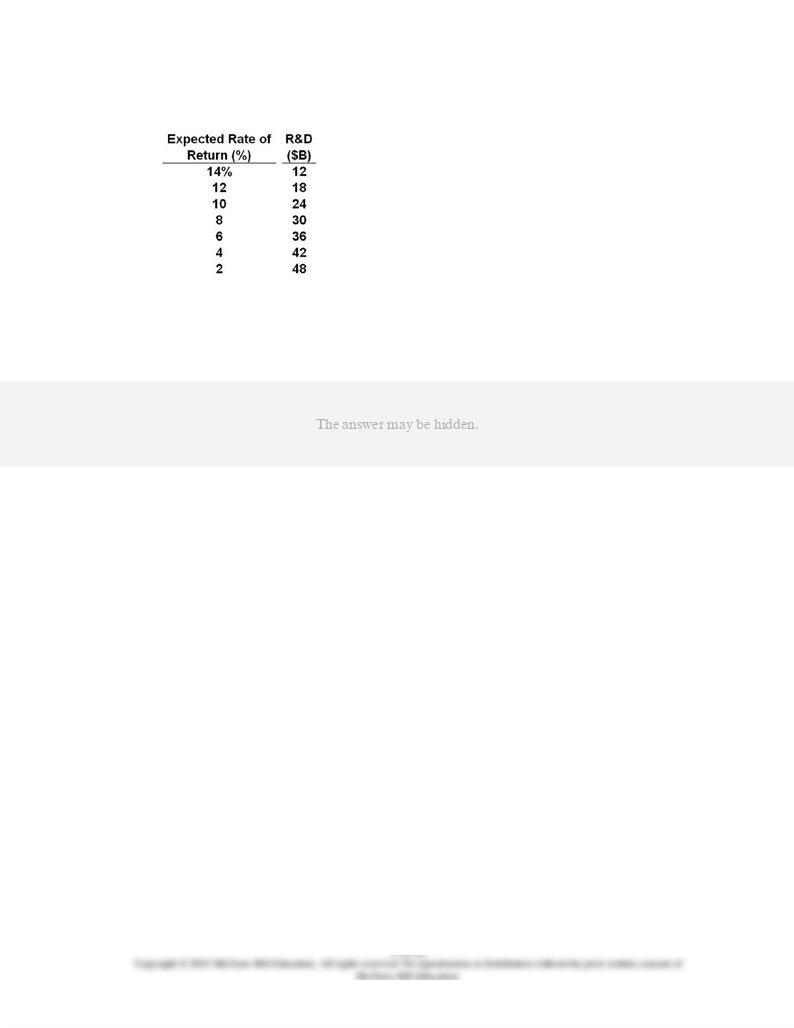
46.
The table below shows the rate of return and R&D spending for a hypothetical firm.
Refer to the above table. Assume the interest-rate cost of funds is 8 percent. What will be
the marginal cost and the marginal benefit of the optimal amount of R&D spending?
AACSB: Analytic
Blooms: Apply
Difficulty: 2 Medium
Learning Objective: 13W-03 Summarize how a firm determines its optimal amount of research and development (R and
D).
Topic: A Firm's Optimal Amount of R and D
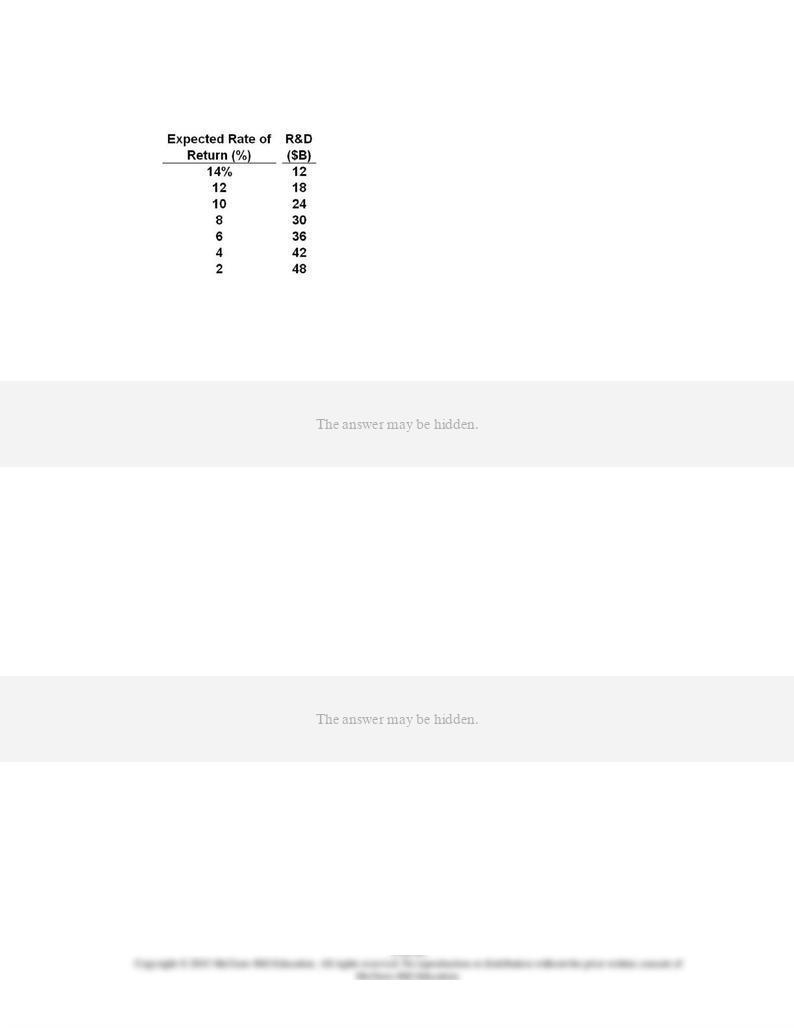
47.
The table below shows the rate of return and R&D spending for a hypothetical firm.
Refer to the above table. Assume the interest-rate cost of funds falls from 10 percent to 6
percent. What will happen to the optimal amount of R&D spending?
AACSB: Analytic
Blooms: Apply
Difficulty: 2 Medium
Learning Objective: 13W-03 Summarize how a firm determines its optimal amount of research and development (R and
D).
Topic: A Firm's Optimal Amount of R and D
48.
An amount of R&D spending that is less than the optimal amount indicates that the:
AACSB: Analytic
Accessibility: Keyboard Navigation
Blooms: Remember
Difficulty: 3 Hard
Learning Objective: 13W-03 Summarize how a firm determines its optimal amount of research and development (R and
D).
Topic: A Firm's Optimal Amount of R and D

49.
An amount of R&D spending that is greater than the optimal amount indicates that the:
AACSB: Analytic
Accessibility: Keyboard Navigation
Blooms: Remember
Difficulty: 2 Medium
Learning Objective: 13W-03 Summarize how a firm determines its optimal amount of research and development (R and
D).
Topic: A Firm's Optimal Amount of R and D
50.
A firm should increase the amount of R&D expenditures to:
AACSB: Analytic
Accessibility: Keyboard Navigation
Blooms: Remember
Difficulty: 2 Medium
Learning Objective: 13W-03 Summarize how a firm determines its optimal amount of research and development (R and
D).
Topic: A Firm's Optimal Amount of R and D
51.
The outcomes from R&D expenditures by firms are:
AACSB: Analytic

Accessibility: Keyboard Navigation
Blooms: Remember
Difficulty: 3 Hard
Learning Objective: 13W-03 Summarize how a firm determines its optimal amount of research and development (R and
D).
Topic: A Firm's Optimal Amount of R and D
52.
The following can increase the profits of an innovating firm,
except
:
AACSB: Reflective Thinking
Accessibility: Keyboard Navigation
Blooms: Remember
Difficulty: 1 Easy
Learning Objective: 13W-04 Discuss how technological change can increase profits by raising revenues or lowering costs.
Topic: Increased Profit via Innovation
53.
Product innovation would be successful only if it makes the product's:
AACSB: Analytic
Accessibility: Keyboard Navigation
Blooms: Remember
Difficulty: 1 Easy
Learning Objective: 13W-04 Discuss how technological change can increase profits by raising revenues or lowering costs.
Topic: Increased Profit via Innovation

54.
Consumers will make a decision to purchase a new product only if it:
AACSB: Analytic
Accessibility: Keyboard Navigation
Blooms: Remember
Difficulty: 2 Medium
Learning Objective: 13W-04 Discuss how technological change can increase profits by raising revenues or lowering costs.
Topic: Increased Profit via Innovation
55.
A consumer had been consuming product X for some time. This period, she buys fewer X
in order to try some units of a new product Y. She finds that her marginal utility of X is 20
(at a price of $10 per unit), while the marginal utility of Y is 36 (at a price of $12). The
utility-maximizing rule suggests that this consumer should:
AACSB: Analytic
Accessibility: Keyboard Navigation
Blooms: Apply
Difficulty: 2 Medium
Learning Objective: 13W-04 Discuss how technological change can increase profits by raising revenues or lowering costs.
Topic: Increased Profit via Innovation

56.
Assume that a consumer purchases a combination of products. Product A is an old and
reliable product. Product B is a new and appealing product. The MUa/Pa = 40 and MUb/Pb
= 45. To maximize utility without spending more money, the consumer should:
AACSB: Analytic
Blooms: Apply
Difficulty: 3 Hard
Learning Objective: 13W-04 Discuss how technological change can increase profits by raising revenues or lowering costs.
Topic: Increased Profit via Innovation
57.
In choosing between an old reliable product versus a new attractive product, the consumer
will:
AACSB: Analytic
Accessibility: Keyboard Navigation
Blooms: Apply
Difficulty: 2 Medium
Learning Objective: 13W-04 Discuss how technological change can increase profits by raising revenues or lowering costs.
Topic: Increased Profit via Innovation
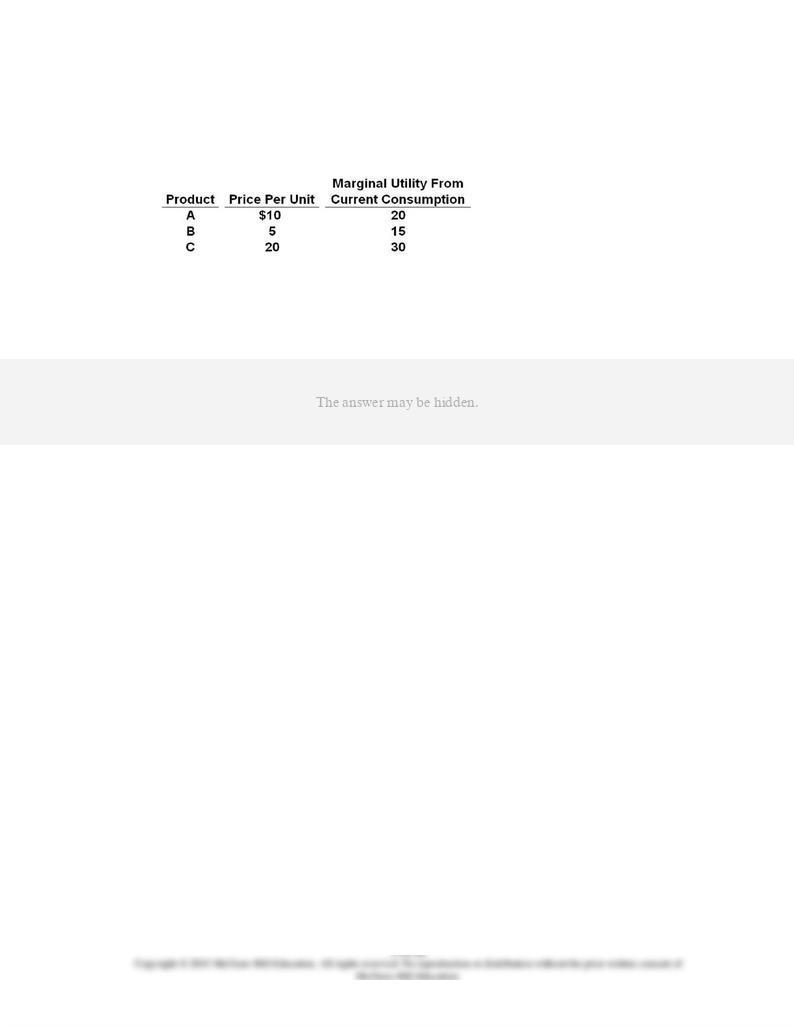
58.
The following table shows the marginal utilities derived from current consumption levels of
three new products, A, B, and C, that are now being sold in the market at the prices listed
below.
The consumer can immediately gain the most extra total utility by switching spending
from:
AACSB: Analytic
Accessibility: Keyboard Navigation
Blooms: Apply
Difficulty: 3 Hard
Learning Objective: 13W-04 Discuss how technological change can increase profits by raising revenues or lowering costs.
Topic: Increased Profit via Innovation
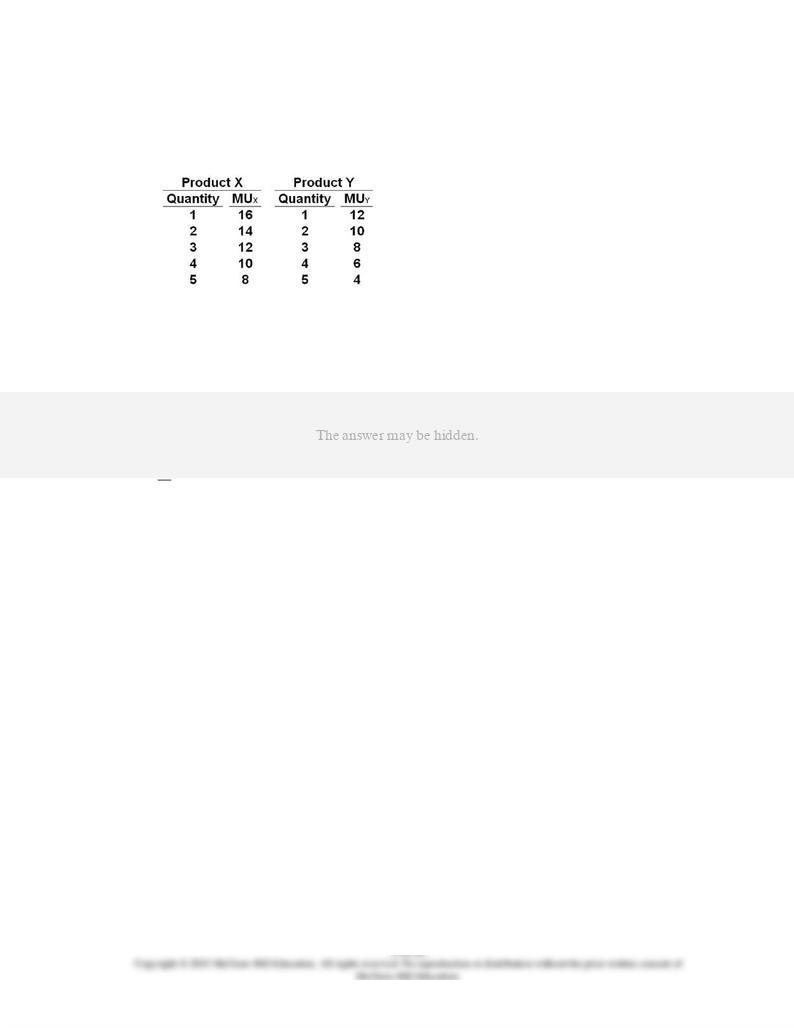
59.
The table below shows the marginal utility schedules for old product X and new product Y
for a hypothetical consumer. The price of X is $2 and the price of good Y is $1. The budget
of the consumer is $10.
Refer to the above table. If the consumer can only buy old product X, how much will the
consumer buy and what will be the total utility from spending the given budget?
AACSB: Analytic
Blooms: Apply
Difficulty: 2 Medium
Learning Objective: 13W-04 Discuss how technological change can increase profits by raising revenues or lowering costs.
Topic: Increased Profit via Innovation
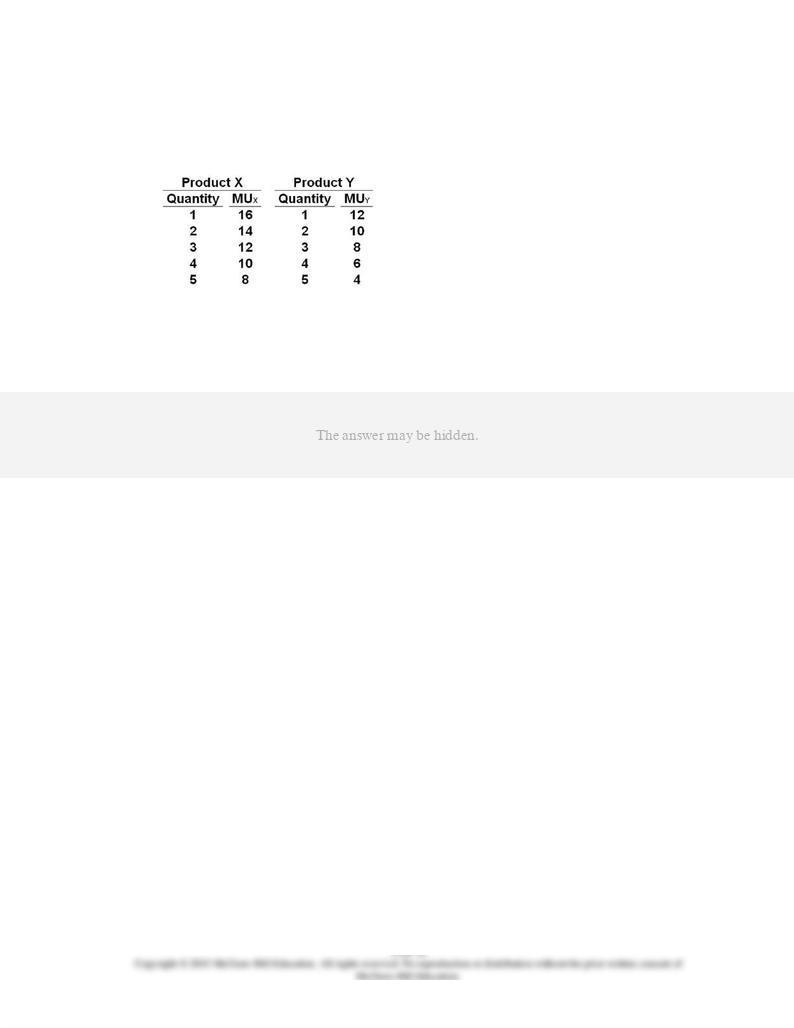
60.
The table below shows the marginal utility schedules for old product X and new product Y
for a hypothetical consumer. The price of X is $2 and the price of good Y is $1. The budget
of the consumer is $10.
Refer to the above table. If the consumer buys both old product X and new product Y, how
much will the consumer buy of each to maximize utility?
AACSB: Analytic
Blooms: Apply
Difficulty: 2 Medium
Learning Objective: 13W-04 Discuss how technological change can increase profits by raising revenues or lowering costs.
Topic: Increased Profit via Innovation
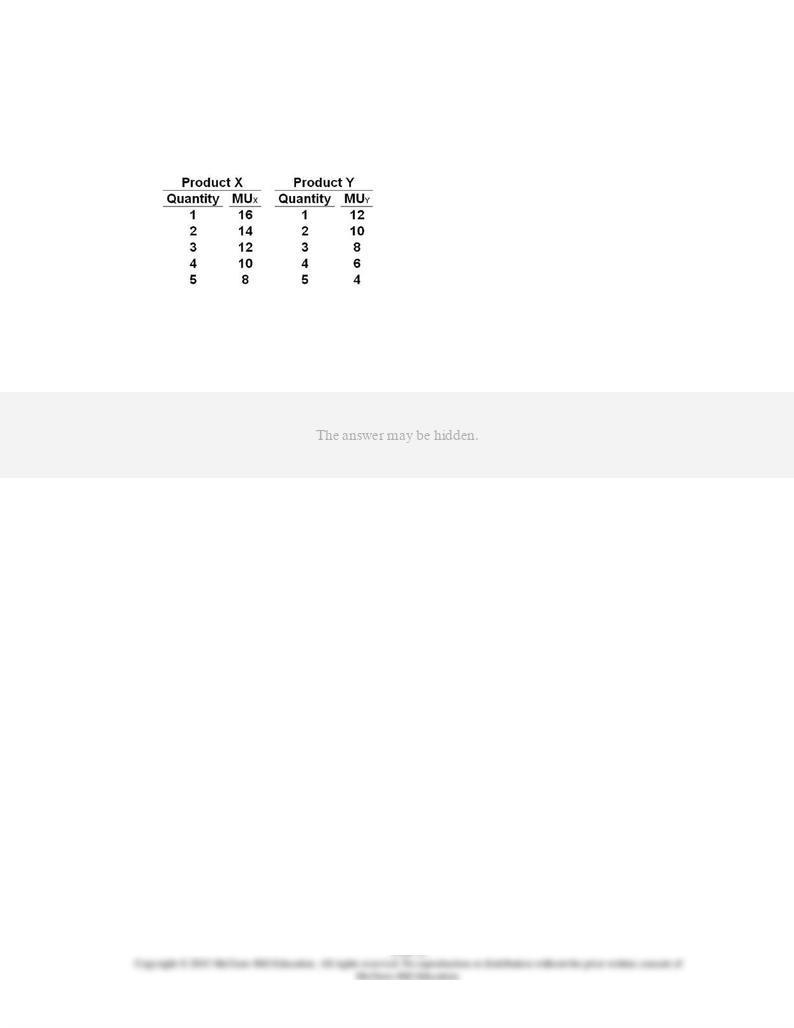
61.
The table below shows the marginal utility schedules for old product X and new product Y
for a hypothetical consumer. The price of X is $2 and the price of good Y is $1. The budget
of the consumer is $10.
Refer to the above table. When the consumer purchases the utility-maximizing
combination of old product X and new product Y, total utility will be:
AACSB: Analytic
Blooms: Apply
Difficulty: 3 Hard
Learning Objective: 13W-04 Discuss how technological change can increase profits by raising revenues or lowering costs.
Topic: Increased Profit via Innovation
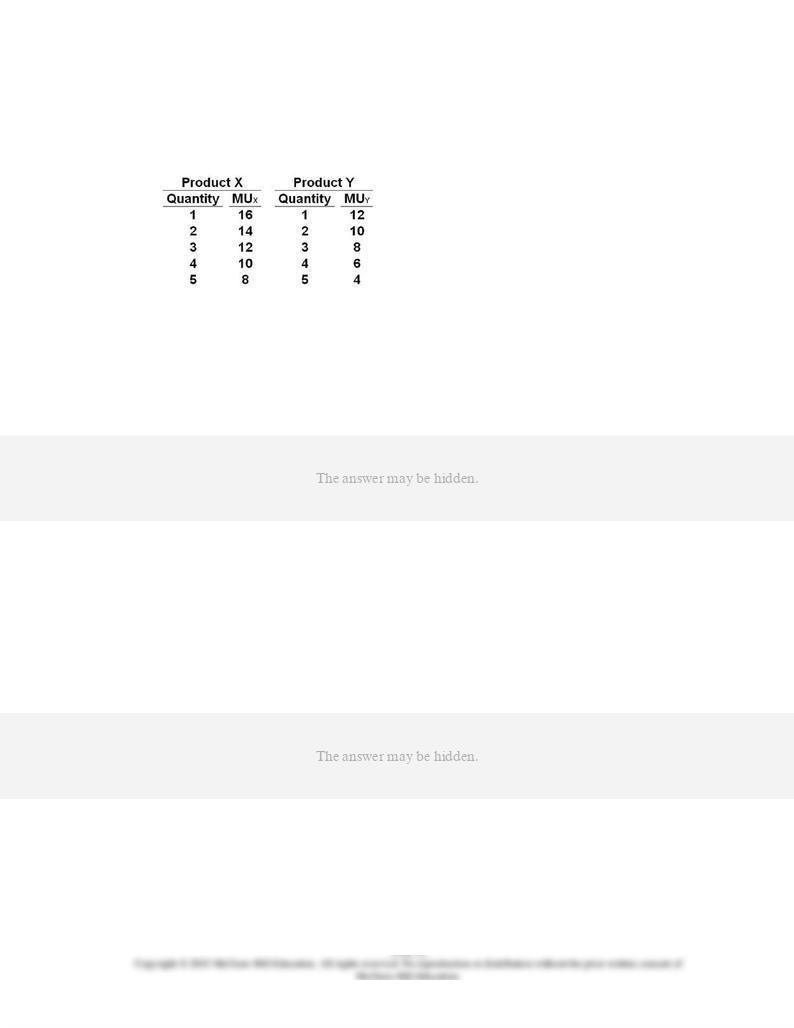
62.
The table below shows the marginal utility schedules for old product X and new product Y
for a hypothetical consumer. The price of X is $2 and the price of good Y is $1. The budget
of the consumer is $10.
Refer to the above table. The consumer was originally limited to purchasing old product X
but now can also purchase new product Y. What is the increase in total utility from the
original situation when the consumer purchases the utility-maximizing combination of both
X and Y?
AACSB: Analytic
Blooms: Apply
Difficulty: 3 Hard
Learning Objective: 13W-04 Discuss how technological change can increase profits by raising revenues or lowering costs.
Topic: Increased Profit via Innovation
63.
Consumer acceptance of a new product depends on:
AACSB: Analytic
Accessibility: Keyboard Navigation
Blooms: Remember
Difficulty: 3 Hard
Learning Objective: 13W-04 Discuss how technological change can increase profits by raising revenues or lowering costs.
Topic: Increased Profit via Innovation

64.
Which would be a good example of a
successful
introduction of a new product?
AACSB: Analytic
Accessibility: Keyboard Navigation
Blooms: Remember
Difficulty: 1 Easy
Learning Objective: 13W-04 Discuss how technological change can increase profits by raising revenues or lowering costs.
Topic: Increased Profit via Innovation
65.
Henry Ford's development of an assembly method for building cars and trucks would be an
example of:
AACSB: Analytic
Accessibility: Keyboard Navigation
Blooms: Remember
Difficulty: 1 Easy
Learning Objective: 13W-04 Discuss how technological change can increase profits by raising revenues or lowering costs.
Topic: Increased Profit via Innovation
66.
Process innovation will shift a firm's:
AACSB: Analytic
Accessibility: Keyboard Navigation

Blooms: Apply
Difficulty: 1 Easy
Learning Objective: 13W-04 Discuss how technological change can increase profits by raising revenues or lowering costs.
Topic: Increased Profit via Innovation
67.
If a firm improves its production method, this change will shift the firm's:
AACSB: Analytic
Accessibility: Keyboard Navigation
Blooms: Apply
Difficulty: 2 Medium
Learning Objective: 13W-04 Discuss how technological change can increase profits by raising revenues or lowering costs.
Topic: Increased Profit via Innovation
68.
If a firm develops better methods of producing a product, then this process innovation can
be expected to result in a(n):
AACSB: Analytic
Accessibility: Keyboard Navigation
Blooms: Apply
Difficulty: 2 Medium
Learning Objective: 13W-04 Discuss how technological change can increase profits by raising revenues or lowering costs.
Topic: Increased Profit via Innovation

69.
Assume a firm faces these costs: total cost of capital = $4,000; price paid for labor = $20
per labor unit; and price paid for raw materials = $8 per raw-material unit.
Refer to the above information. If the firm can produce 2,000 units of output by combining
its fixed capital with 200 units of labor and 500 units of raw materials, what are the total
cost (TC) and average total cost (ATC) of producing the 2,000 units of output?
AACSB: Analytic
Blooms: Apply
Difficulty: 2 Medium
Learning Objective: 13W-04 Discuss how technological change can increase profits by raising revenues or lowering costs.
Topic: Increased Profit via Innovation
70.
Assume a firm faces these costs: total cost of capital = $4,000; price paid for labor = $20
per labor unit; and price paid for raw materials = $8 per raw-material unit.
Refer to the above information. A firm improves its production process so that it can
produce 3,000 units of output by combining its fixed capital with 100 units of labor and 500
units of raw materials. What are the total cost and average cost of producing the 3,000
units of output?
AACSB: Analytic
Blooms: Apply
Difficulty: 2 Medium
Learning Objective: 13W-04 Discuss how technological change can increase profits by raising revenues or lowering costs.
Topic: Increased Profit via Innovation

71.
Assume a firm faces these costs: total cost of capital = $4,000; price paid for labor = $20
per labor unit; and price paid for raw materials = $8 per raw-material unit.
Refer to the above information. Originally the firm produced 2,000 units of output by
combining its fixed capital with 200 units of labor and 500 units of raw materials. Now the
firm improves its production process so that it can produce 3,000 units of output by
combining its fixed capital with 100 units of labor and 500 units of raw materials. What
happened to total cost?
AACSB: Analytic
Blooms: Analyze
Difficulty: 3 Hard
Learning Objective: 13W-04 Discuss how technological change can increase profits by raising revenues or lowering costs.
Topic: Increased Profit via Innovation
72.
Assume a firm faces these costs: total cost of capital = $4,000; price paid for labor = $20
per labor unit; and price paid for raw materials = $8 per raw-material unit.
Refer to the above information. Originally the firm produced 2,000 units of output by
combining its fixed capital with 200 units of labor and 500 units of raw materials. Now the
firm changes its production process so that it can produce 3,000 units of output by
combining its fixed capital with 100 units of labor and 500 units of raw materials. What
happened to average total cost?
AACSB: Analytic
Blooms: Analyze
Difficulty: 3 Hard
Learning Objective: 13W-04 Discuss how technological change can increase profits by raising revenues or lowering costs.
Topic: Increased Profit via Innovation

73.
Assume a firm faces these costs: total cost of capital = $4,000; price paid for labor = $20
per labor unit; and price paid for raw materials = $8 per raw-material unit.
Refer to the above information. Originally the firm produced 2,000 units of output by
combining its fixed capital with 200 units of labor and 500 units of raw materials. Now the
firm changes its production process so that it can produce 3,000 units of output by
combining its fixed capital with 100 units of labor and 500 units of raw materials. What
valid conclusion can be drawn about the effect and reasons for the change?
AACSB: Analytic
Blooms: Apply
Difficulty: 2 Medium
Learning Objective: 13W-04 Discuss how technological change can increase profits by raising revenues or lowering costs.
Topic: Increased Profit via Innovation

74.
Refer to the above diagram. Process innovation will tend to:
AACSB: Analytic
Blooms: Remember
Difficulty: 1 Easy
Learning Objective: 13W-04 Discuss how technological change can increase profits by raising revenues or lowering costs.
Topic: Increased Profit via Innovation
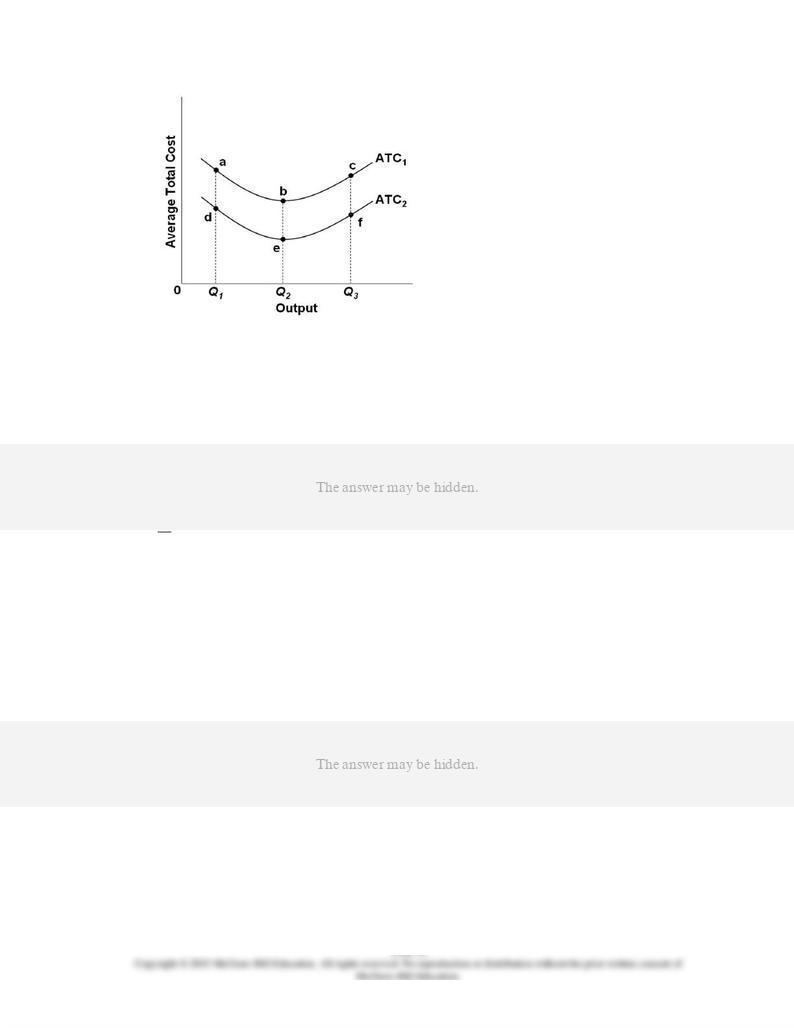
75.
Refer to the above diagram. Assume the firm is currently producing at Q1 with average cost
associated with point
a.
A process innovation will reduce average costs from point
a
to
point:
AACSB: Analytic
Blooms: Understand
Difficulty: 2 Medium
Learning Objective: 13W-04 Discuss how technological change can increase profits by raising revenues or lowering costs.
Topic: Increased Profit via Innovation
76.
The following statements apply when a firm's rivals imitate its innovation,
except
:
AACSB: Reflective Thinking
Accessibility: Keyboard Navigation
Blooms: Understand
Difficulty: 2 Medium
Learning Objective: 13W-05 Relate why firms can benefit from their innovation even though rivals have an incentive to

imitate it.
Topic: Imitation and R and D Incentives
77.
A "fast-second strategy" means that a dominant firm in an industry:
AACSB: Analytic
Accessibility: Keyboard Navigation
Blooms: Remember
Difficulty: 3 Hard
Learning Objective: 13W-05 Relate why firms can benefit from their innovation even though rivals have an incentive to
imitate it.
Topic: Imitation and R and D Incentives
78.
When a dominant firm quickly copies the new product innovation of a smaller firm so that
it is the next firm to make the innovation, it is following a:
AACSB: Analytic
Accessibility: Keyboard Navigation
Blooms: Remember
Difficulty: 1 Easy
Learning Objective: 13W-05 Relate why firms can benefit from their innovation even though rivals have an incentive to
imitate it.
Topic: Imitation and R and D Incentives

79.
The legal protection for publishers of books, computer software, movies, videos, and
musical compositions from having their works used or copied by others without their
permission is a:
AACSB: Analytic
Accessibility: Keyboard Navigation
Blooms: Remember
Difficulty: 2 Medium
Learning Objective: 13W-05 Relate why firms can benefit from their innovation even though rivals have an incentive to
imitate it.
Topic: Imitation and R and D Incentives
80.
The legal protection that gives the original innovators of products the exclusive right to
use a particular product name is a:
AACSB: Analytic
Accessibility: Keyboard Navigation
Blooms: Remember
Difficulty: 1 Easy
Learning Objective: 13W-05 Relate why firms can benefit from their innovation even though rivals have an incentive to
imitate it.
Topic: Imitation and R and D Incentives

81.
A legal protection for taking the lead in innovation is:
AACSB: Analytic
Accessibility: Keyboard Navigation
Blooms: Remember
Difficulty: 2 Medium
Learning Objective: 13W-05 Relate why firms can benefit from their innovation even though rivals have an incentive to
imitate it.
Topic: Imitation and R and D Incentives
82.
One of the major advantages of being the first to develop a product is:
AACSB: Analytic
Accessibility: Keyboard Navigation
Blooms: Remember
Difficulty: 2 Medium
Learning Objective: 13W-05 Relate why firms can benefit from their innovation even though rivals have an incentive to
imitate it.
Topic: Imitation and R and D Incentives
83.
Which market structure has a strong incentive for product development and
differentiation?
AACSB: Analytic

Accessibility: Keyboard Navigation
Blooms: Remember
Difficulty: 2 Medium
Learning Objective: 13W-06 Discuss the role of market structure in promoting technological advance.
Topic: Role of Market Structure
84.
Under which market structure are profit rewards most likely to be quickly taken away by
existing firms or new firms entering the industry?
AACSB: Analytic
Accessibility: Keyboard Navigation
Blooms: Remember
Difficulty: 2 Medium
Learning Objective: 13W-06 Discuss the role of market structure in promoting technological advance.
Topic: Role of Market Structure
85.
Which market structure is most likely to have the means and some incentive to innovate?
AACSB: Analytic
Accessibility: Keyboard Navigation
Blooms: Remember
Difficulty: 2 Medium
Learning Objective: 13W-06 Discuss the role of market structure in promoting technological advance.
Topic: Role of Market Structure

86.
Which two market structures have a strong need to innovate but have low expected
returns on R&D expenditures?
AACSB: Analytic
Accessibility: Keyboard Navigation
Blooms: Remember
Difficulty: 2 Medium
Learning Objective: 13W-06 Discuss the role of market structure in promoting technological advance.
Topic: Role of Market Structure
87.
Which market structure offers little incentive to engage in R&D?
AACSB: Analytic
Accessibility: Keyboard Navigation
Blooms: Remember
Difficulty: 1 Easy
Learning Objective: 13W-06 Discuss the role of market structure in promoting technological advance.
Topic: Role of Market Structure
88.
The "Inverted-U theory" of R&D shows the relationship between:
AACSB: Analytic
Accessibility: Keyboard Navigation
Blooms: Remember

Difficulty: 2 Medium
Learning Objective: 13W-06 Discuss the role of market structure in promoting technological advance.
Topic: Role of Market Structure
89.
An industry with which of the following four-firm concentration ratios would tend to have
the greatest amount of R&D expenditures as a percentage of sales?
AACSB: Analytic
Accessibility: Keyboard Navigation
Blooms: Remember
Difficulty: 2 Medium
Learning Objective: 13W-06 Discuss the role of market structure in promoting technological advance.
Topic: Role of Market Structure
90.
According to the inverted-U theory, R&D expenditures as a percentage of sales tend to be
relatively low in:
AACSB: Analytic
Accessibility: Keyboard Navigation
Blooms: Remember
Difficulty: 3 Hard
Learning Objective: 13W-06 Discuss the role of market structure in promoting technological advance.
Topic: Role of Market Structure

91.
The optimal market structure for technological advance seems to be an industry in which:
AACSB: Analytic
Accessibility: Keyboard Navigation
Blooms: Remember
Difficulty: 2 Medium
Learning Objective: 13W-06 Discuss the role of market structure in promoting technological advance.
Topic: Role of Market Structure
92.
Besides market structure, another factor that seems to influence the level of R&D
spending in an industry is the:
AACSB: Analytic
Accessibility: Keyboard Navigation
Blooms: Remember
Difficulty: 2 Medium
Learning Objective: 13W-06 Discuss the role of market structure in promoting technological advance.
Topic: Role of Market Structure
93.
One of the outcomes for society from product innovation is:
AACSB: Analytic
Accessibility: Keyboard Navigation
Blooms: Remember

Difficulty: 1 Easy
Learning Objective: 13W-06 Discuss the role of market structure in promoting technological advance.
Topic: Role of Market Structure
94.
Process innovation leads to technological advance because it:
AACSB: Analytic
Accessibility: Keyboard Navigation
Blooms: Remember
Difficulty: 2 Medium
Learning Objective: 13W-07 Show how technological advance enhances productive efficiency and allocative efficiency.
Topic: Technological Advance and Efficiency
95.
Product innovation contributes to technological advance primarily by:
AACSB: Analytic
Accessibility: Keyboard Navigation
Blooms: Remember
Difficulty: 1 Easy
Learning Objective: 13W-07 Show how technological advance enhances productive efficiency and allocative efficiency.
Topic: Technological Advance and Efficiency

96.
In the 1800s, railroads broke up the monopoly position of wagons, ships, and barges as the
major means of transporting goods. This would be an example of:
AACSB: Analytic
Accessibility: Keyboard Navigation
Blooms: Apply
Difficulty: 1 Easy
Learning Objective: 13W-07 Show how technological advance enhances productive efficiency and allocative efficiency.
Topic: Technological Advance and Efficiency
97.
In the music industry, cassette tapes were replaced by compact discs, which in turn are
replaced by the iPod and MP3 technology. This process would be an example of:
AACSB: Analytic
Accessibility: Keyboard Navigation
Blooms: Apply
Difficulty: 2 Medium
Learning Objective: 13W-07 Show how technological advance enhances productive efficiency and allocative efficiency.
Topic: Technological Advance and Efficiency

98.
Joseph Schumpeter viewed capitalism as a process of "creative destruction" because:
AACSB: Analytic
Accessibility: Keyboard Navigation
Blooms: Remember
Difficulty: 2 Medium
Learning Objective: 13W-07 Show how technological advance enhances productive efficiency and allocative efficiency.
Topic: Technological Advance and Efficiency
99.
To maintain returns from research and development, firms:
AACSB: Analytic
Accessibility: Keyboard Navigation
Blooms: Remember
Difficulty: 1 Easy
Learning Objective: 13W-07 Show how technological advance enhances productive efficiency and allocative efficiency.
Topic: Technological Advance and Efficiency
100.
All of the following statements are true about technological advance,
except
:
AACSB: Reflective Thinking
Accessibility: Keyboard Navigation
Blooms: Remember

Difficulty: 1 Easy
Learning Objective: 13W-07 Show how technological advance enhances productive efficiency and allocative efficiency.
Topic: Technological Advance and Efficiency
101.
Compared to the mid-1960s, the percentage of the U.S. Federal budget spent on R&D in
recent years is:
AACSB: Analytic
Accessibility: Keyboard Navigation
Blooms: Remember
Difficulty: 1 Easy
Learning Objective: 13W-07 Show how technological advance enhances productive efficiency and allocative efficiency.
Topic: Technological Advance and Efficiency
102.
Which of the following programs receives the smallest share of total Federal spending?
AACSB: Analytic
Accessibility: Keyboard Navigation
Blooms: Remember
Difficulty: 1 Easy
Learning Objective: 13W-07 Show how technological advance enhances productive efficiency and allocative efficiency.
Topic: Technological Advance and Efficiency
True / False Questions
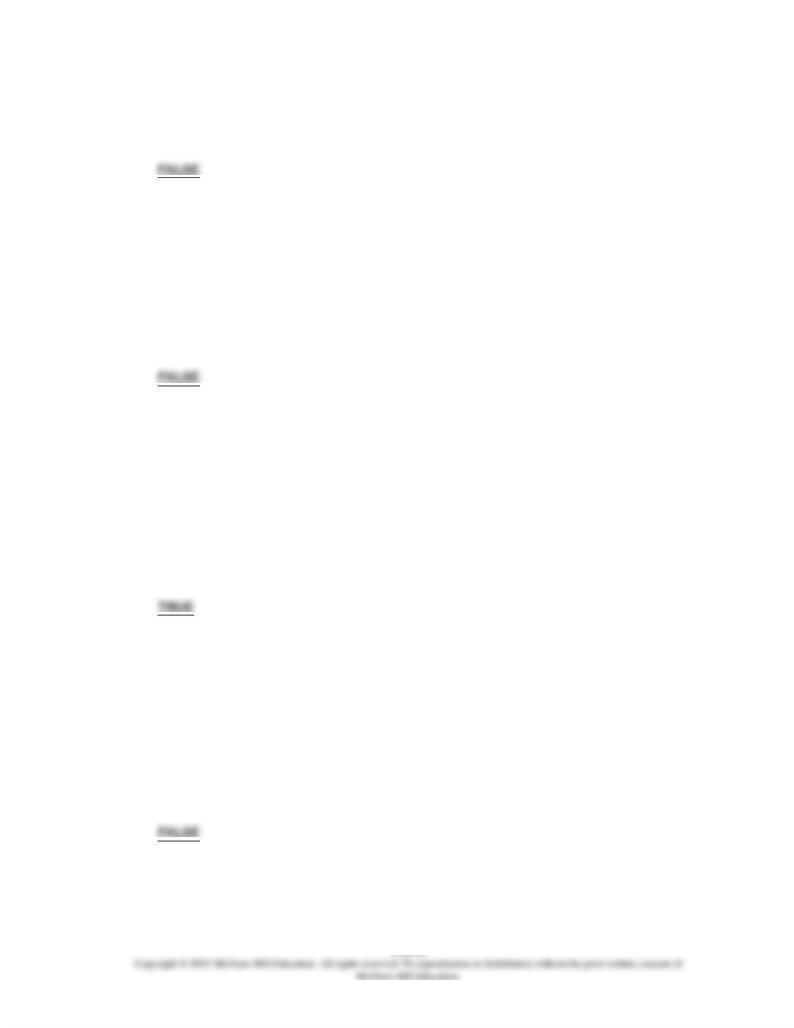
103.
Technological advance consists of short-run adjustments to the production process that
reduce costs.
AACSB: Analytic
Accessibility: Keyboard Navigation
Blooms: Remember
Difficulty: 2 Medium
Learning Objective: 13W-01 Differentiate between invention; innovation; and technological diffusion.
Topic: Invention, Innovation, and Diffusion
104.
Inventions and innovations can both be patented.
AACSB: Analytic
Accessibility: Keyboard Navigation
Blooms: Understand
Difficulty: 2 Medium
Learning Objective: 13W-01 Differentiate between invention; innovation; and technological diffusion.
Topic: Invention, Innovation, and Diffusion
105.
Innovation pertains to commercialization, while invention pertains more to scientific
research.
AACSB: Analytic
AACSB: Communication
Accessibility: Keyboard Navigation
Blooms: Understand
Difficulty: 1 Easy
Learning Objective: 13W-01 Differentiate between invention; innovation; and technological diffusion.
Topic: Invention, Innovation, and Diffusion
106.
U.S. business firms channel a majority of their R&D expenditures to scientific research.
AACSB: Analytic
Accessibility: Keyboard Navigation
Blooms: Remember
Difficulty: 1 Easy

Learning Objective: 13W-01 Differentiate between invention; innovation; and technological diffusion.
Topic: Invention, Innovation, and Diffusion
107.
The modern view of technological advance is that it is an external force to which the
economy adjusts.
AACSB: Analytic
Accessibility: Keyboard Navigation
Blooms: Remember
Difficulty: 2 Medium
Learning Objective: 13W-01 Differentiate between invention; innovation; and technological diffusion.
Topic: Invention, Innovation, and Diffusion
108.
Many economists view technological advance as mainly a response to profit opportunities
arising within a capitalist economy, and not some random external force.
AACSB: Analytic
Accessibility: Keyboard Navigation
Blooms: Remember
Difficulty: 1 Easy
Learning Objective: 13W-01 Differentiate between invention; innovation; and technological diffusion.
Topic: Invention, Innovation, and Diffusion
109.
All inventors are entrepreneurs.
AACSB: Analytic
AACSB: Communication
Accessibility: Keyboard Navigation
Blooms: Remember
Difficulty: 2 Medium
Learning Objective: 13W-02 Explain how entrepreneurs and other innovators further technological advance.
Topic: Role of Entrepreneurs and Other Innovators

110.
R&D activities by government and universities have not been an important factor in
fostering technological advance.
AACSB: Analytic
Accessibility: Keyboard Navigation
Blooms: Remember
Difficulty: 1 Easy
Learning Objective: 13W-02 Explain how entrepreneurs and other innovators further technological advance.
Topic: Role of Entrepreneurs and Other Innovators
111.
Entrepreneurs often form new small firms called "spin-off firms".
AACSB: Analytic
AACSB: Communication
Accessibility: Keyboard Navigation
Blooms: Remember
Difficulty: 1 Easy
Learning Objective: 13W-02 Explain how entrepreneurs and other innovators further technological advance.
Topic: Role of Entrepreneurs and Other Innovators
112.
When entrepreneurs use their own personal savings to finance the R&D for their new
venture, the marginal cost of financing is zero.
AACSB: Analytic
Accessibility: Keyboard Navigation
Blooms: Understand
Difficulty: 2 Medium
Learning Objective: 13W-03 Summarize how a firm determines its optimal amount of research and development (R and
D).
Topic: A Firm's Optimal Amount of R and D
113.
When corporations use retained earnings to finance the R&D for a new venture the
marginal cost of financing is zero.
AACSB: Analytic

Accessibility: Keyboard Navigation
Blooms: Understand
Difficulty: 2 Medium
Learning Objective: 13W-03 Summarize how a firm determines its optimal amount of research and development (R and
D).
Topic: A Firm's Optimal Amount of R and D
114.
The optimal amount of R&D spending for the firm occurs where its expected return is
equal to the interest-rate cost-of-funds to finance it.
AACSB: Analytic
Accessibility: Keyboard Navigation
Blooms: Remember
Difficulty: 1 Easy
Learning Objective: 13W-03 Summarize how a firm determines its optimal amount of research and development (R and
D).
Topic: A Firm's Optimal Amount of R and D
115.
If an R&D activity is affordable, the firm should spend on that activity.
AACSB: Reflective Thinking
Accessibility: Keyboard Navigation
Blooms: Understand
Difficulty: 2 Medium
Learning Objective: 13W-03 Summarize how a firm determines its optimal amount of research and development (R and
D).
Topic: A Firm's Optimal Amount of R and D
116.
If a particular R&D expenditure is expected to be worthwhile, the firm should undertake it
because the project will definitely increase the firm's future profits.
AACSB: Analytic
AACSB: Reflective Thinking
Accessibility: Keyboard Navigation
Blooms: Understand
Difficulty: 2 Medium
Learning Objective: 13W-03 Summarize how a firm determines its optimal amount of research and development (R and
D).
Topic: A Firm's Optimal Amount of R and D
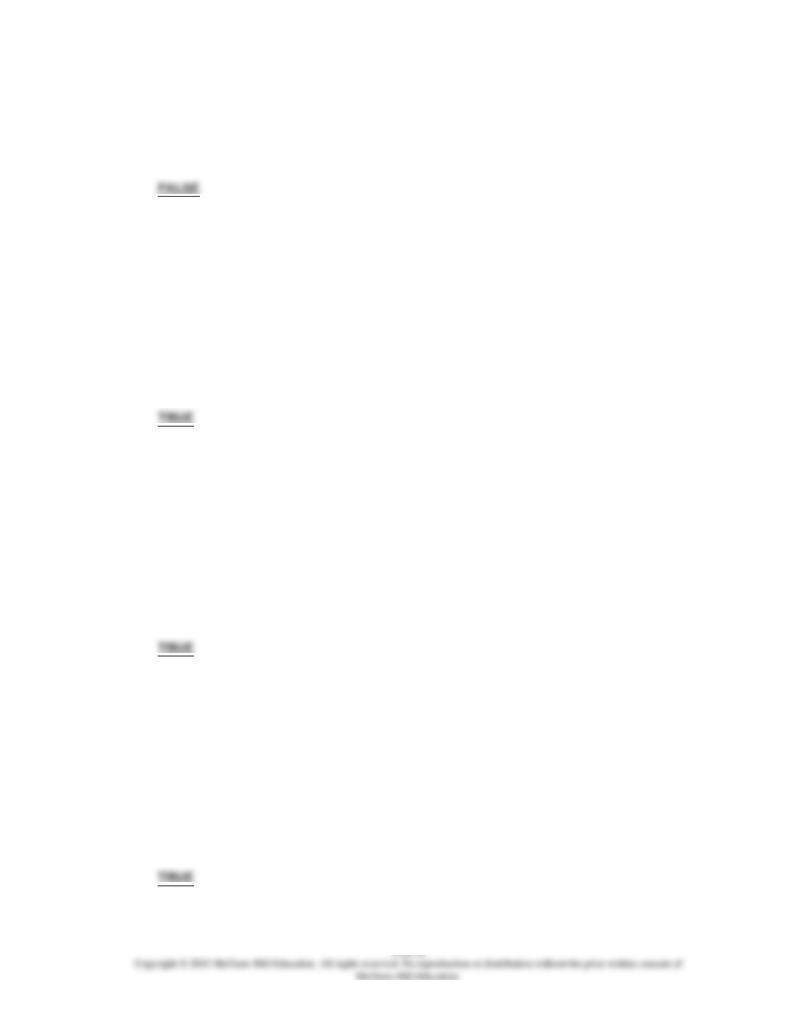
117.
Consumers will buy a new product instead of an old one that they are used to buying, if
the MU of the new product is larger than the MU of the old product.
AACSB: Analytic
Accessibility: Keyboard Navigation
Blooms: Remember
Difficulty: 1 Easy
Learning Objective: 13W-04 Discuss how technological change can increase profits by raising revenues or lowering costs.
Topic: Increased Profit via Innovation
118.
Most product innovations consist of minor changes to existing products and are
incremental improvements.
AACSB: Analytic
Accessibility: Keyboard Navigation
Blooms: Remember
Difficulty: 1 Easy
Learning Objective: 13W-04 Discuss how technological change can increase profits by raising revenues or lowering costs.
Topic: Increased Profit via Innovation
119.
Process innovation raises the firm's total product curve and lowers its average total cost
curve.
AACSB: Analytic
Accessibility: Keyboard Navigation
Blooms: Remember
Difficulty: 1 Easy
Learning Objective: 13W-04 Discuss how technological change can increase profits by raising revenues or lowering costs.
Topic: Increased Profit via Innovation
120.
One of the advantages of being first to develop a new product is the opportunity to
develop brand-name recognition.
AACSB: Analytic
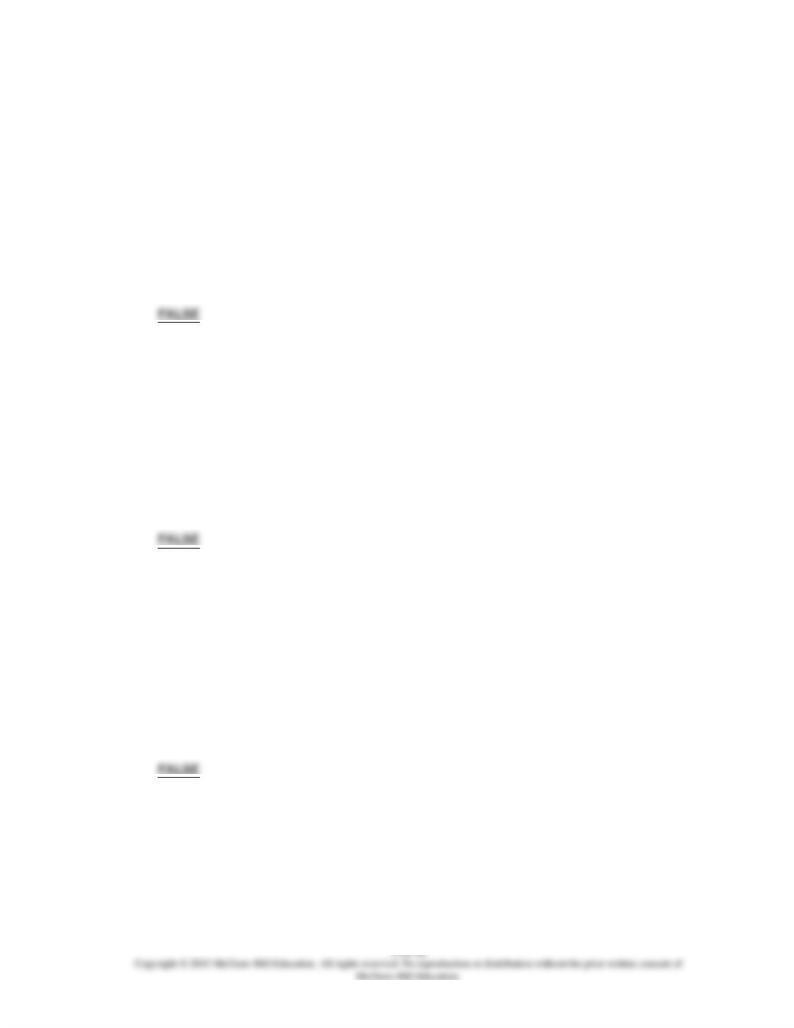
Accessibility: Keyboard Navigation
Blooms: Remember
Difficulty: 1 Easy
Learning Objective: 13W-05 Relate why firms can benefit from their innovation even though rivals have an incentive to
imitate it.
Topic: Imitation and R and D Incentives
121.
A "fast-second strategy" refers to a situation where small competitors of a dominant firm
will wait for the dominant firm to innovate, and then quickly imitate the dominant firm's
innovations.
AACSB: Analytic
Accessibility: Keyboard Navigation
Blooms: Understand
Difficulty: 1 Easy
Learning Objective: 13W-05 Relate why firms can benefit from their innovation even though rivals have an incentive to
imitate it.
Topic: Imitation and R and D Incentives
122.
Pure monopoly is the best market structure for encouraging R&D and innovation.
AACSB: Analytic
Accessibility: Keyboard Navigation
Blooms: Remember
Difficulty: 1 Easy
Learning Objective: 13W-06 Discuss the role of market structure in promoting technological advance.
Topic: Role of Market Structure
123.
The inverted-U theory suggests that R&D effort is strongest in very high concentration
industries.
AACSB: Analytic
Accessibility: Keyboard Navigation
Blooms: Understand
Difficulty: 2 Medium
Learning Objective: 13W-06 Discuss the role of market structure in promoting technological advance.
Topic: Role of Market Structure

124.
The technical and scientific characteristics of an industry may be less important than its
structure in determining R&D spending and innovation.
AACSB: Analytic
Accessibility: Keyboard Navigation
Blooms: Remember
Difficulty: 2 Medium
Learning Objective: 13W-06 Discuss the role of market structure in promoting technological advance.
Topic: Role of Market Structure
125.
Technological advance may lead to new monopolies, and may also destroy existing
monopolies.
AACSB: Reflective Thinking
Accessibility: Keyboard Navigation
Blooms: Remember
Difficulty: 3 Hard
Learning Objective: 13W-07 Show how technological advance enhances productive efficiency and allocative efficiency.
Topic: Technological Advance and Efficiency
126.
Creative destruction is the situation where the creation of new products destroys the
monopoly market positions of firms producing existing products.
AACSB: Analytic
Accessibility: Keyboard Navigation
Blooms: Understand
Difficulty: 1 Easy
Learning Objective: 13W-07 Show how technological advance enhances productive efficiency and allocative efficiency.
Topic: Technological Advance and Efficiency
127.
The U.S. government has been increasing the portion of its budget and its spending on
R&D activities, for the nation's long-term growth.
AACSB: Analytic
Accessibility: Keyboard Navigation

Blooms: Remember
Difficulty: 1 Easy
Learning Objective: 13W-07 Show how technological advance enhances productive efficiency and allocative efficiency.
Topic: Technological Advance and Efficiency